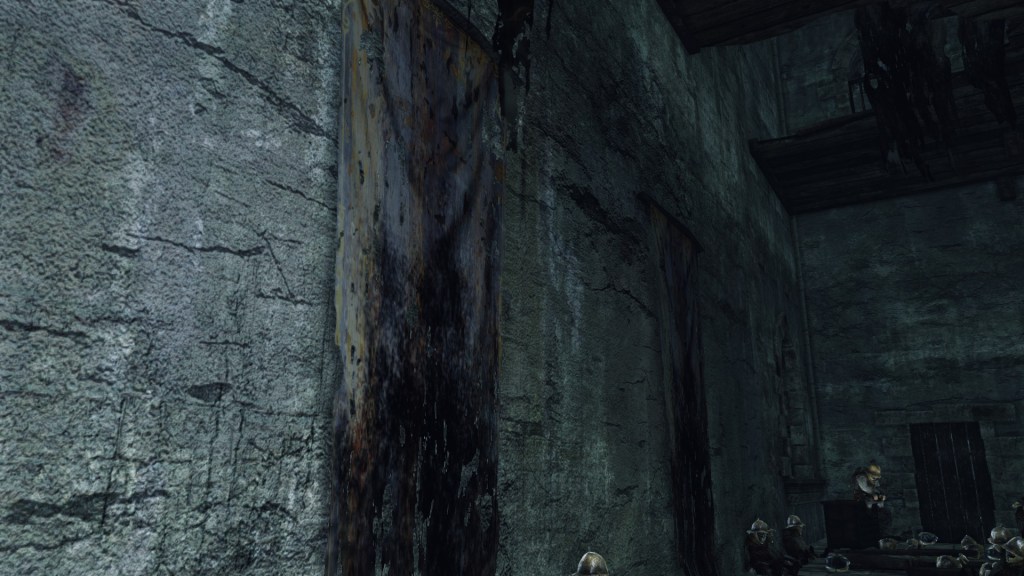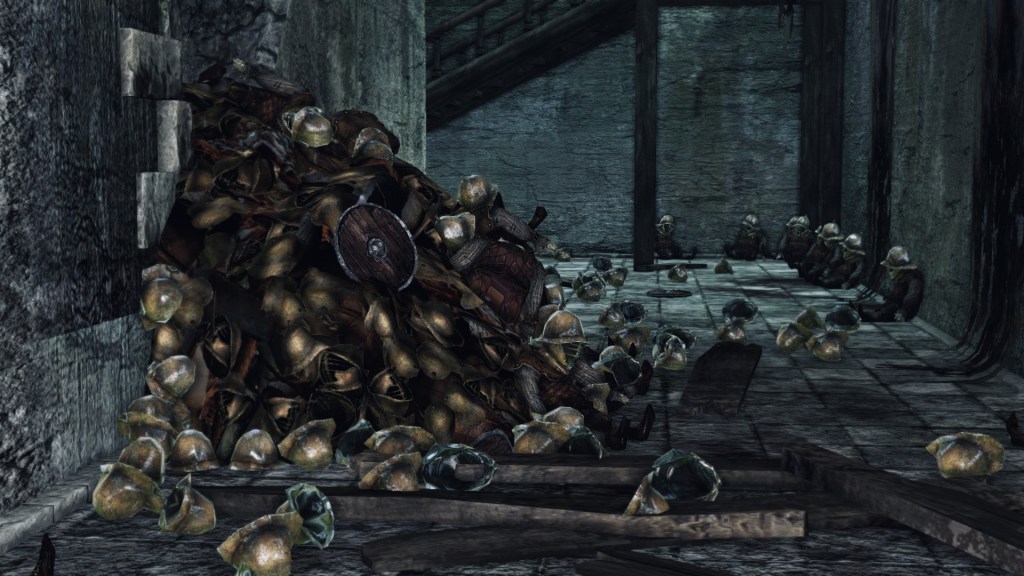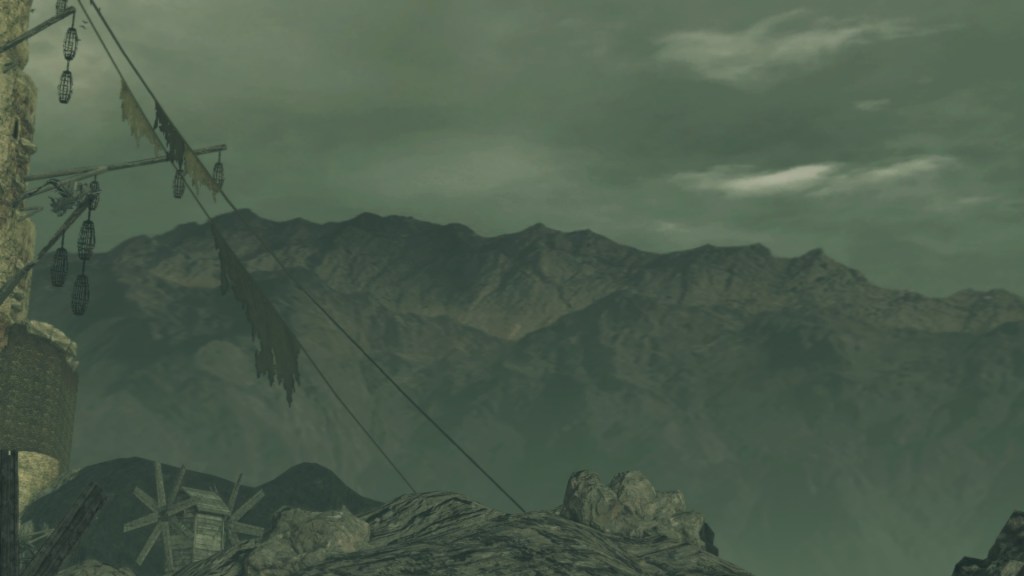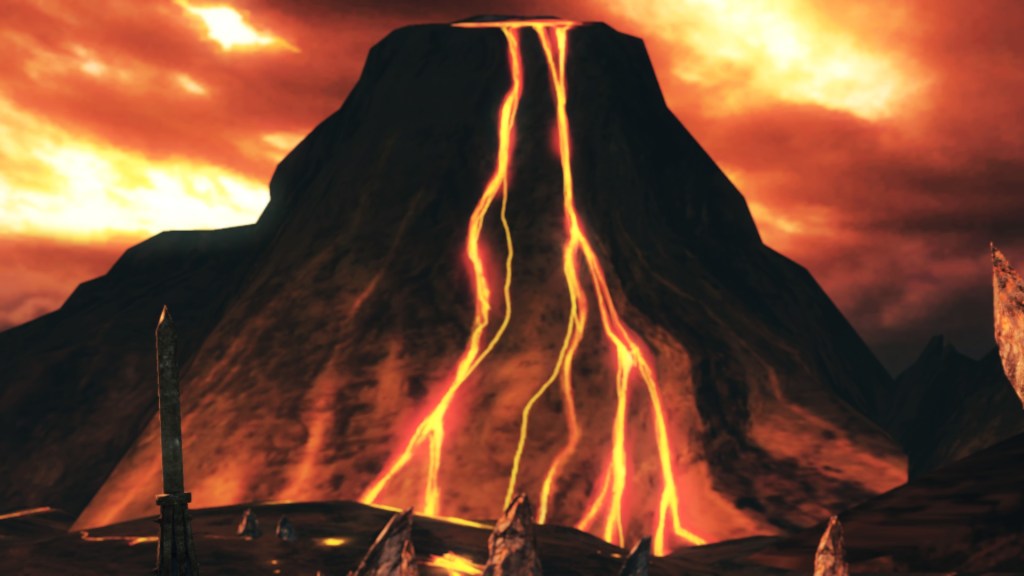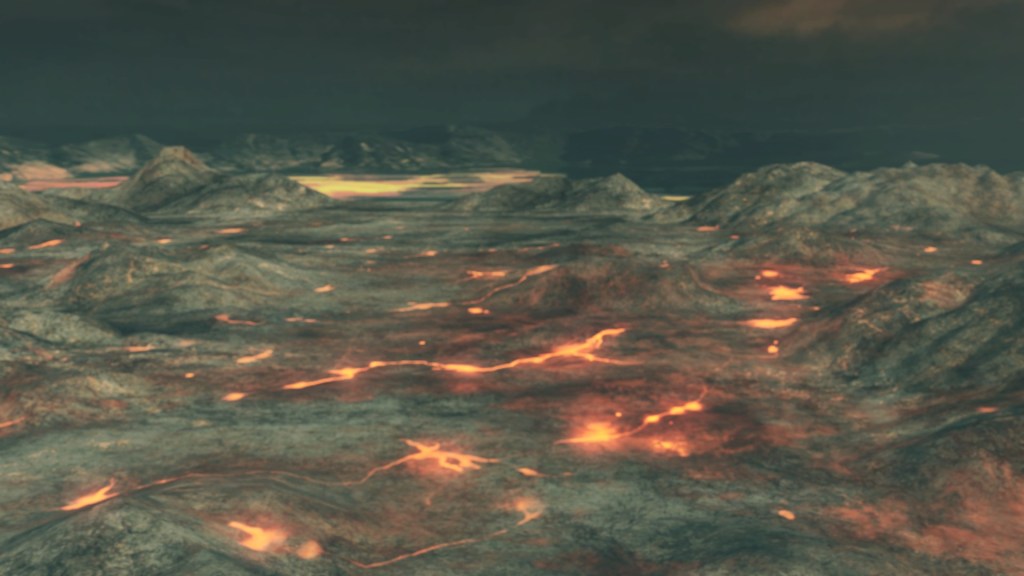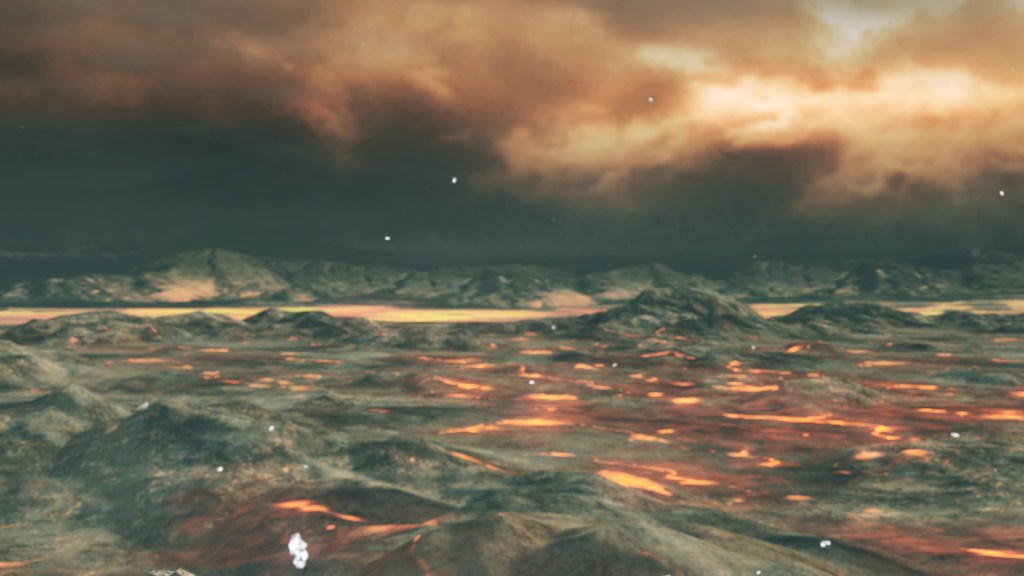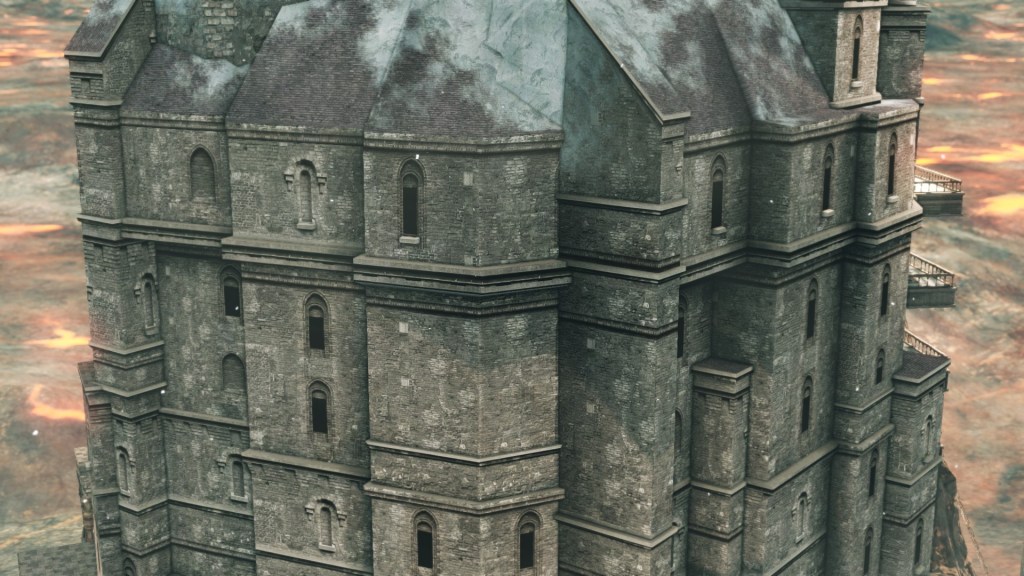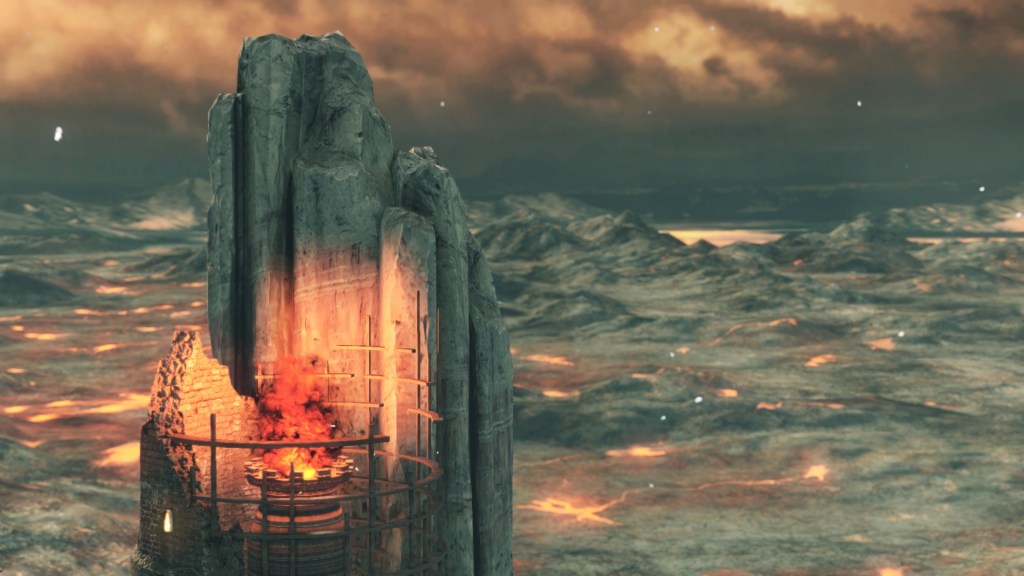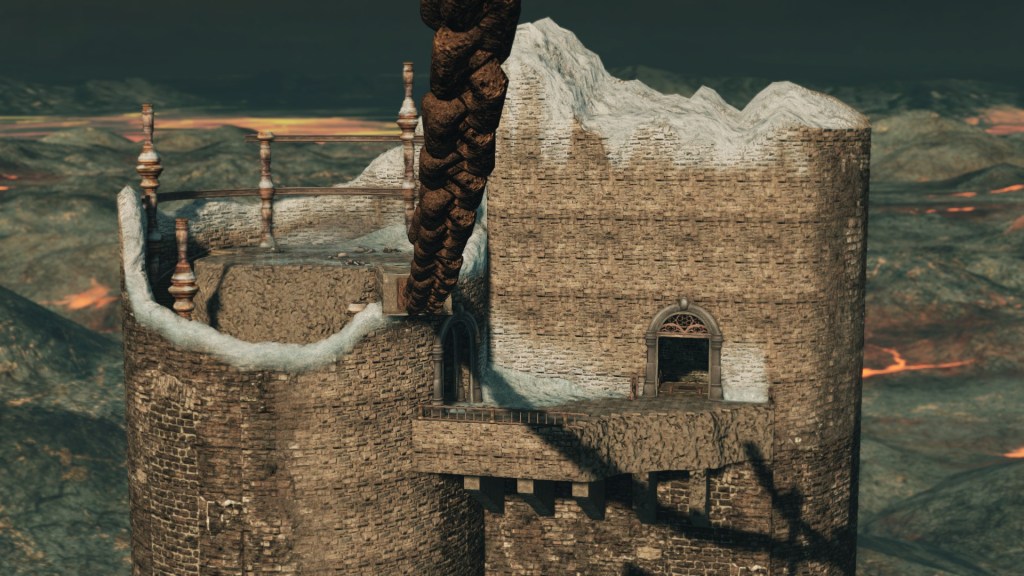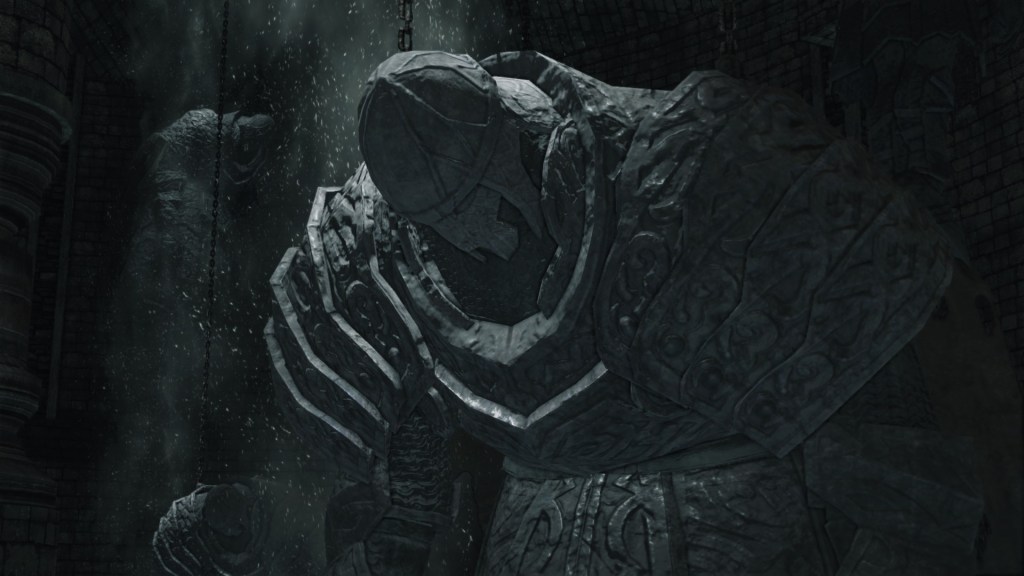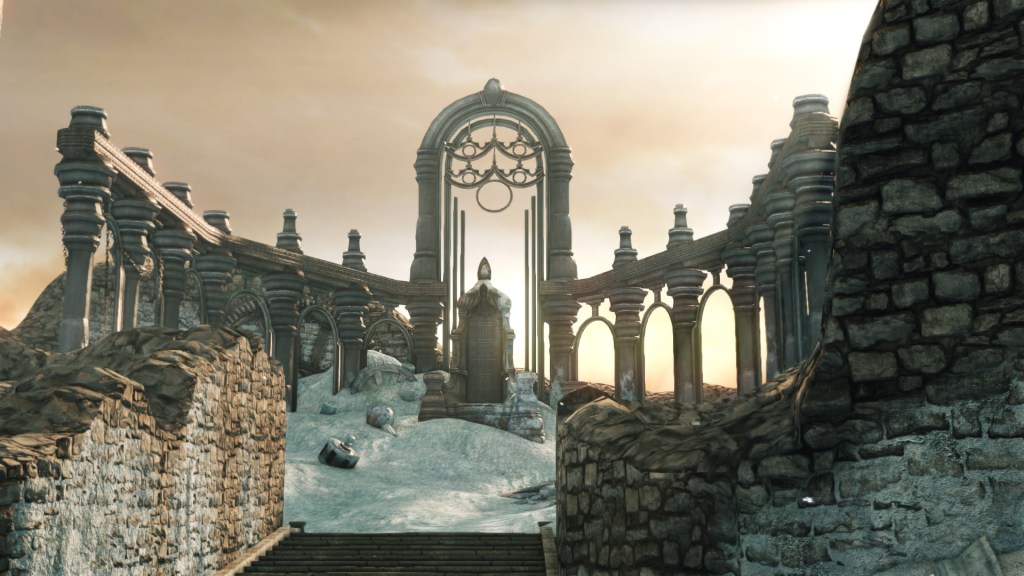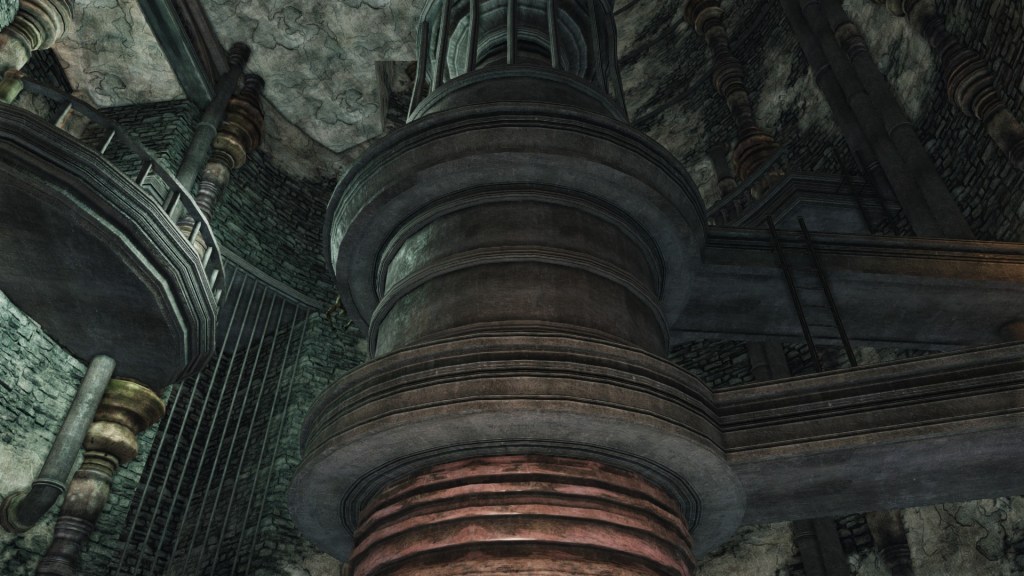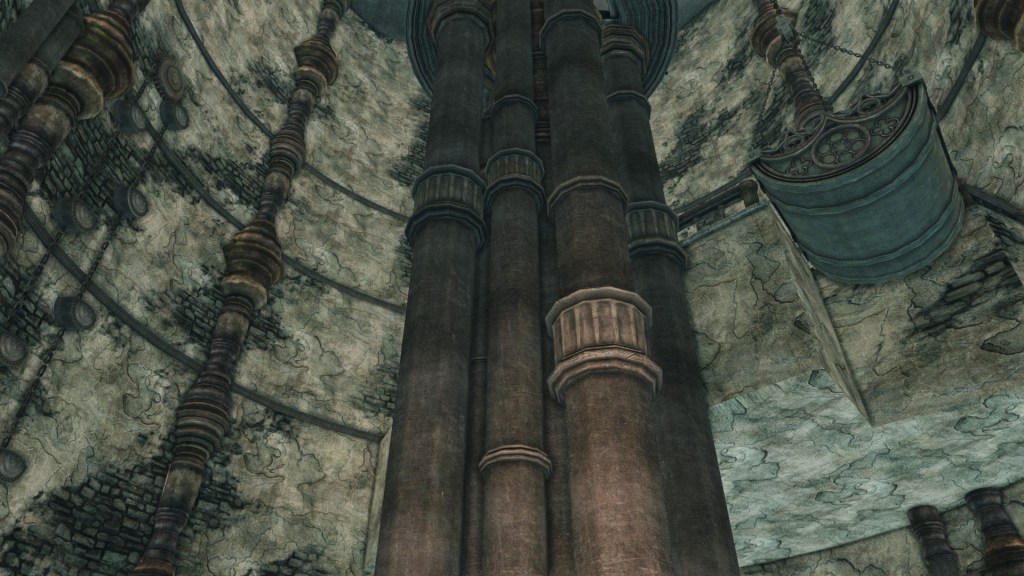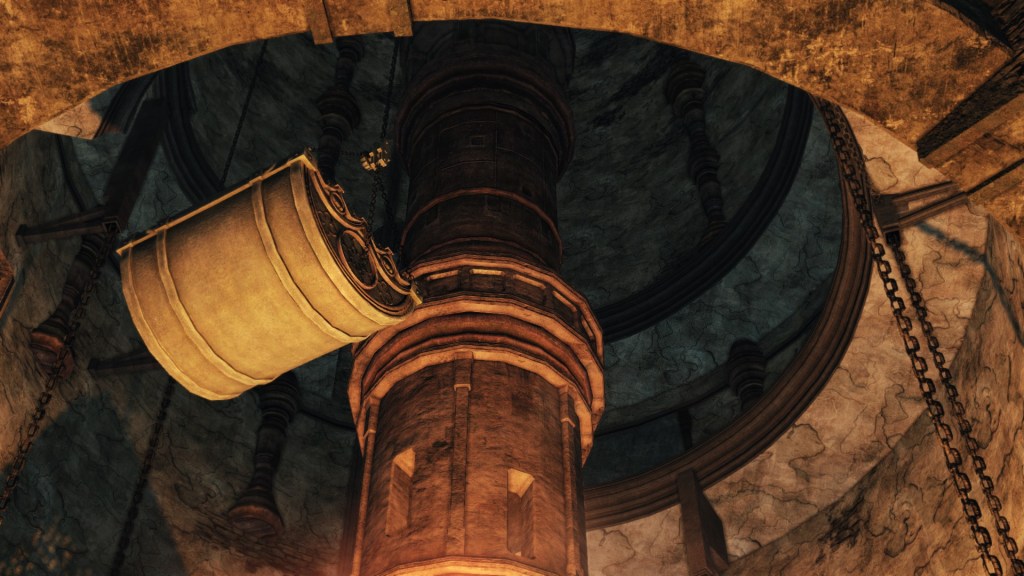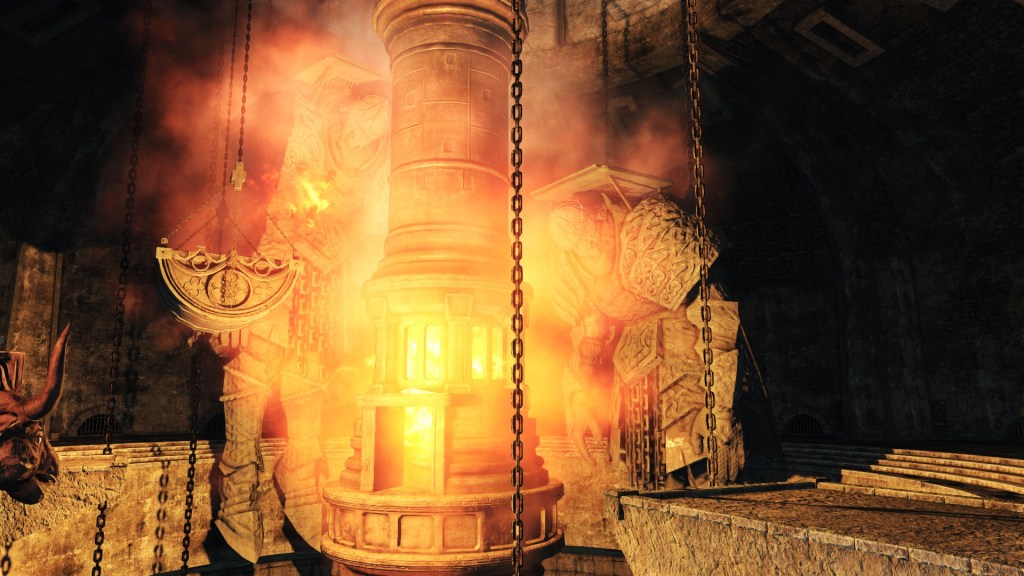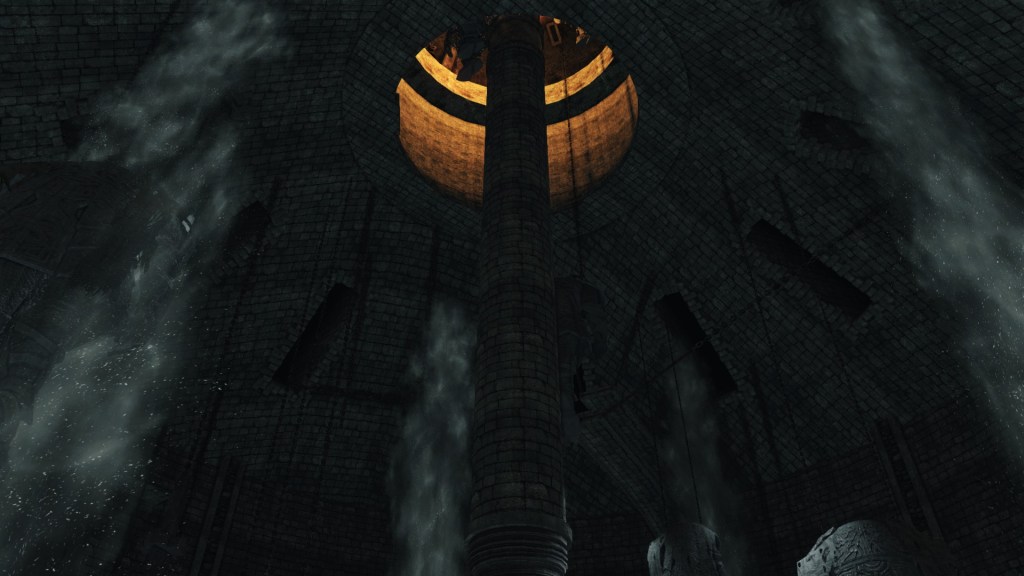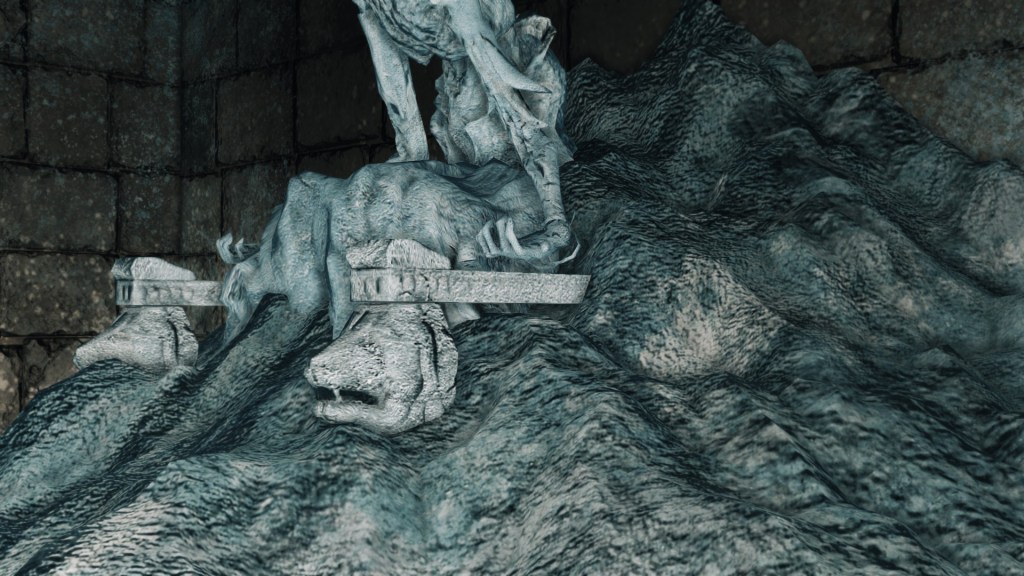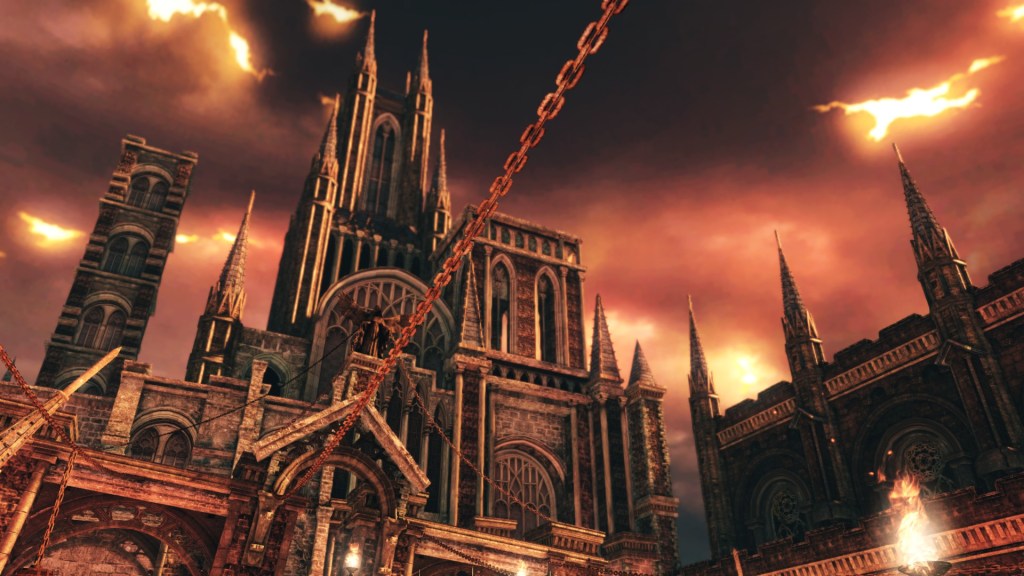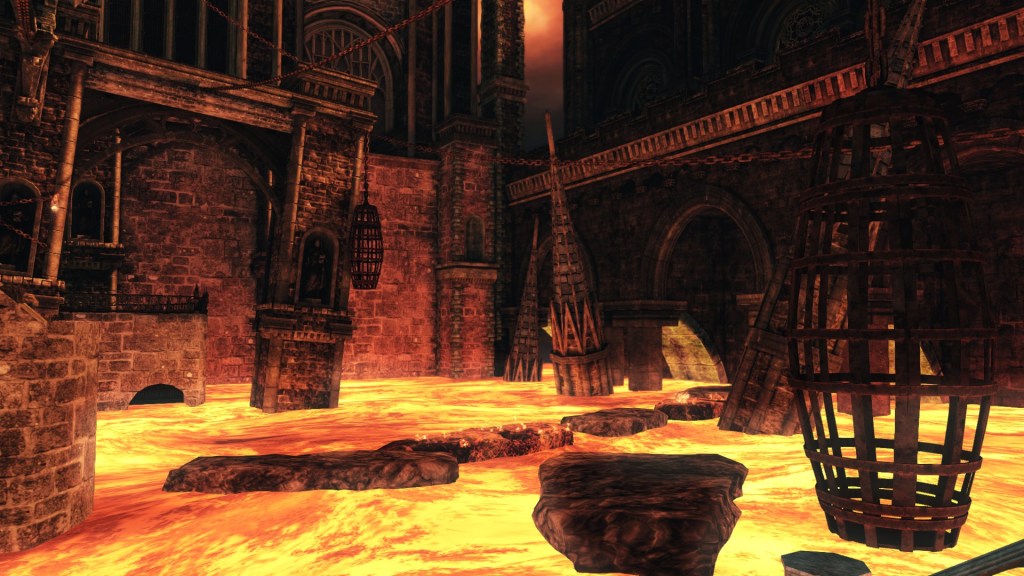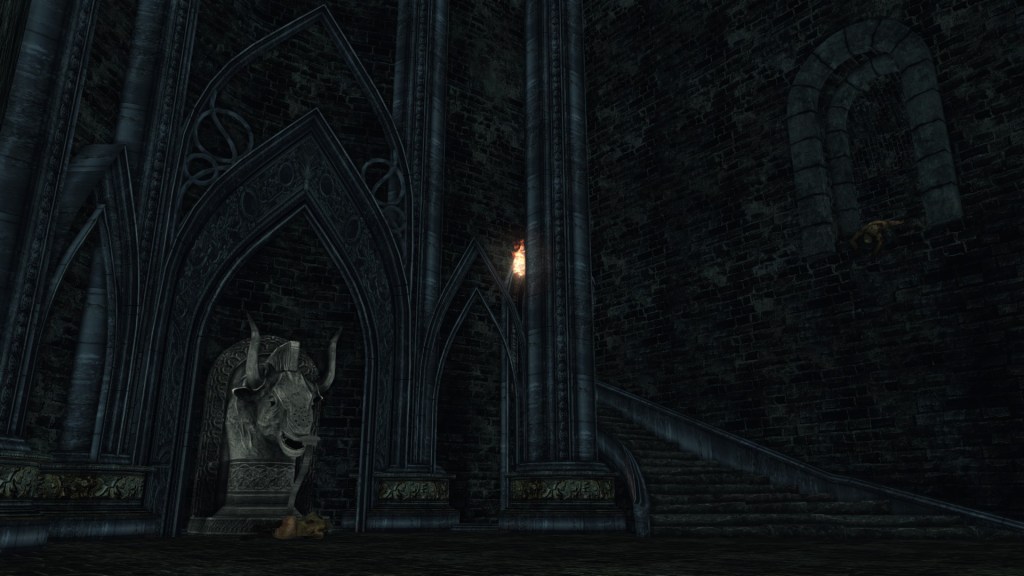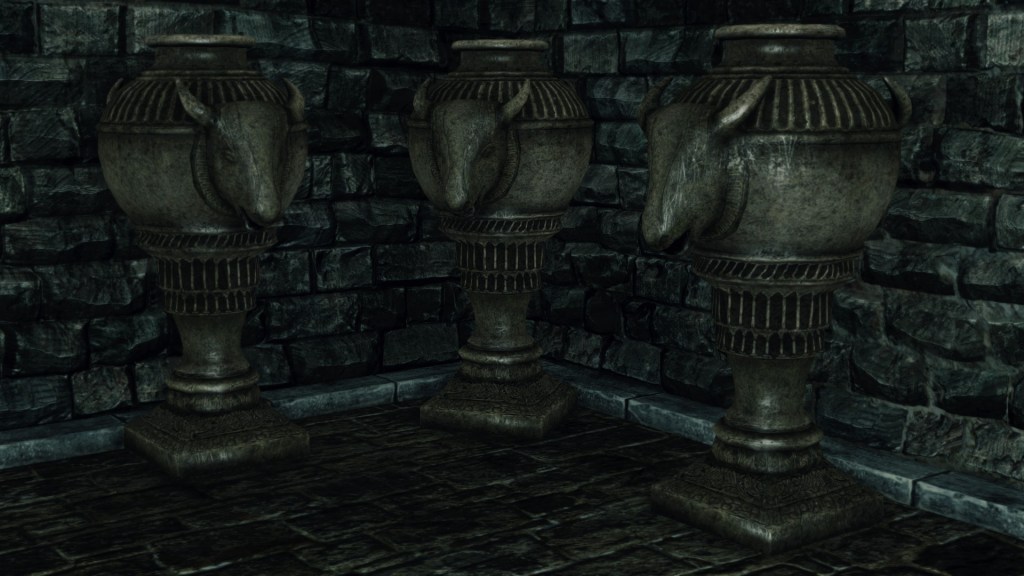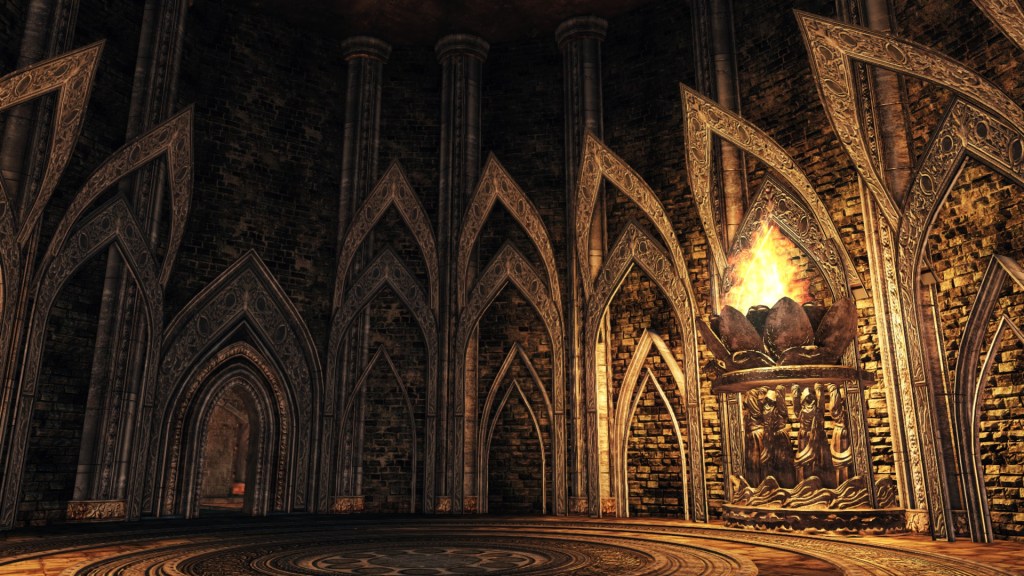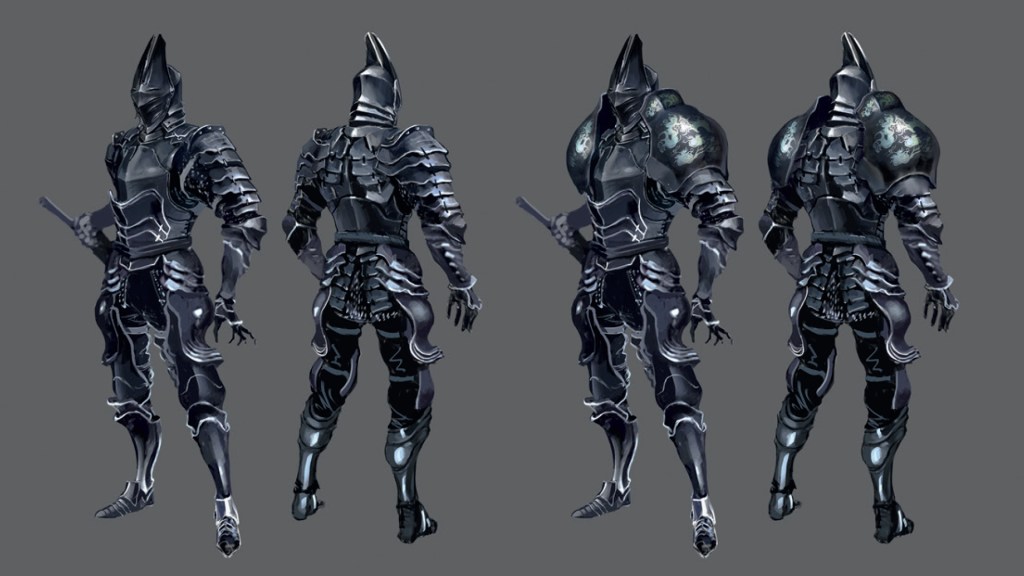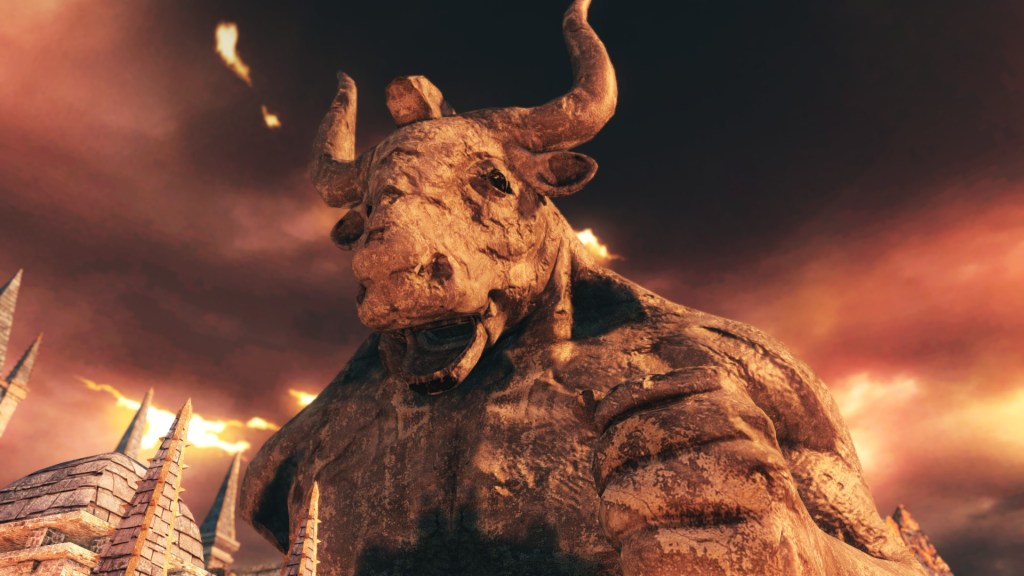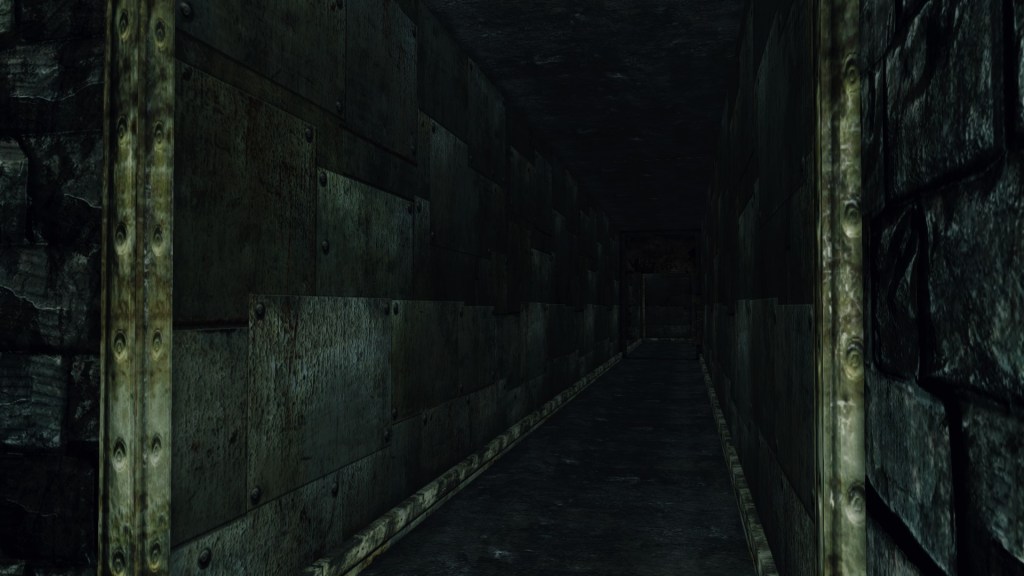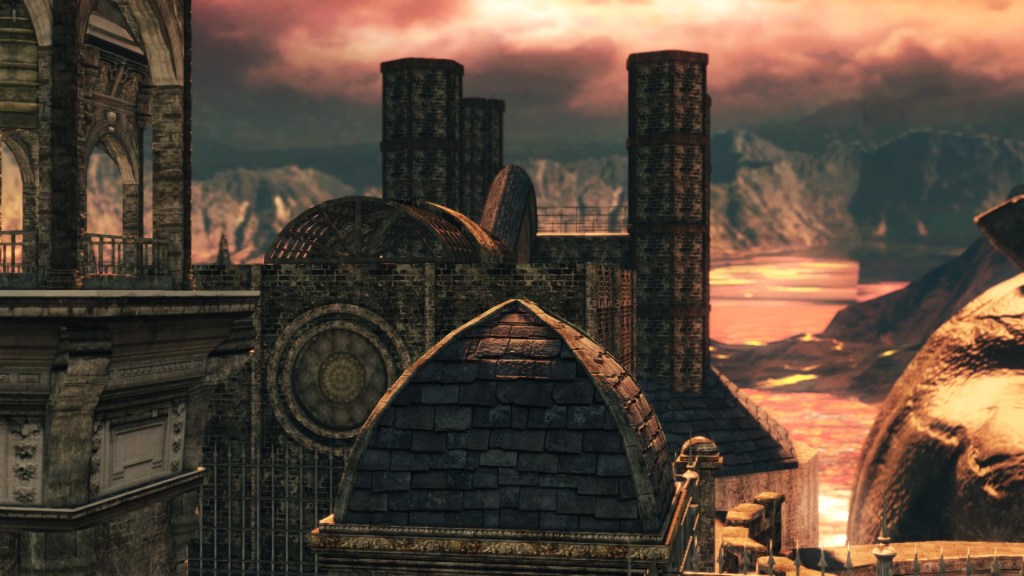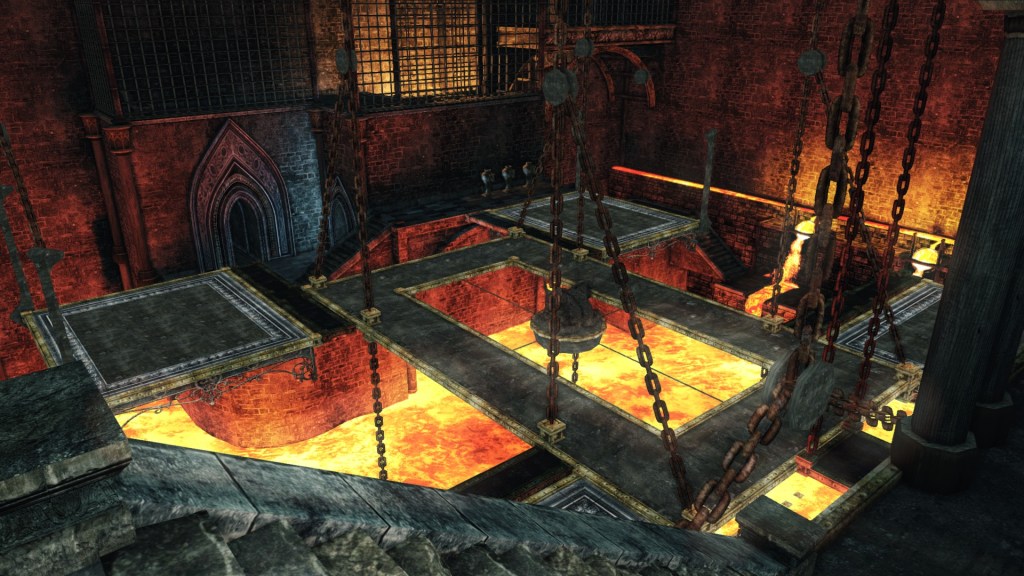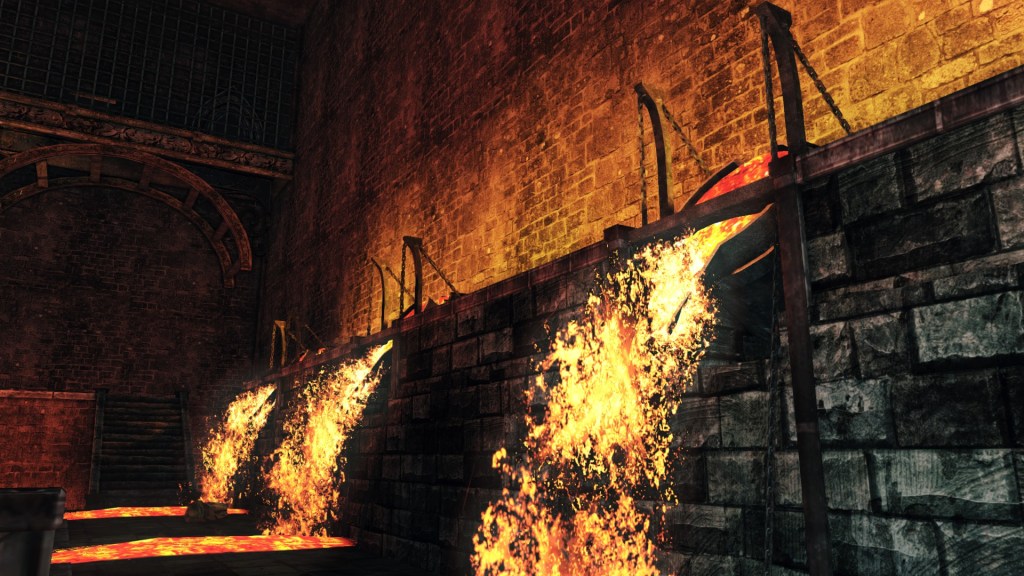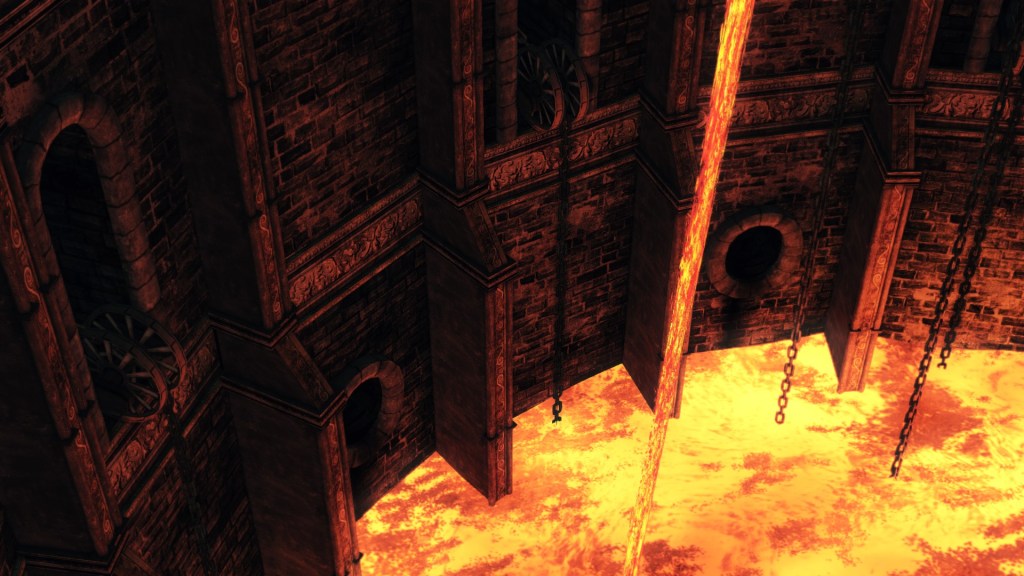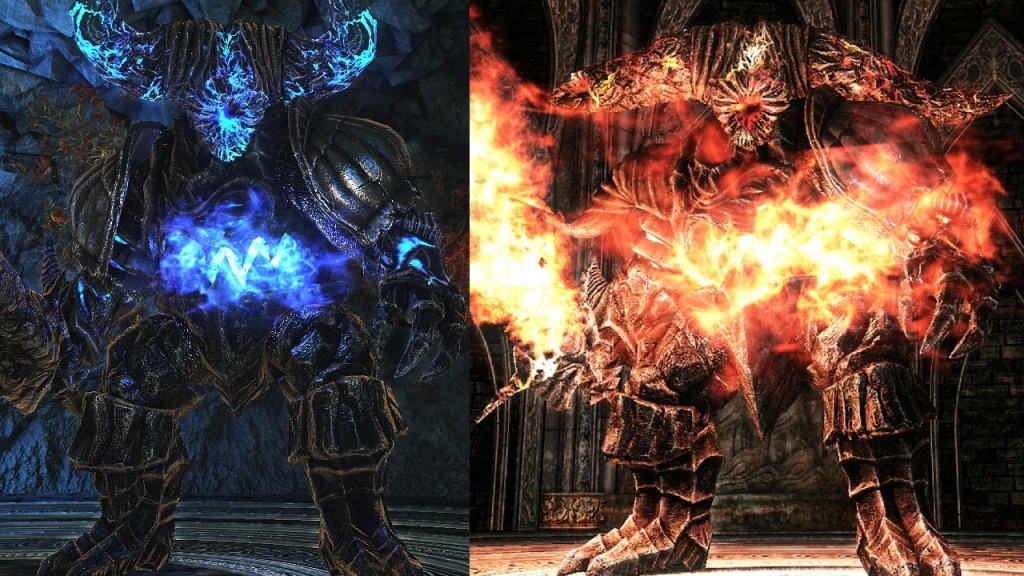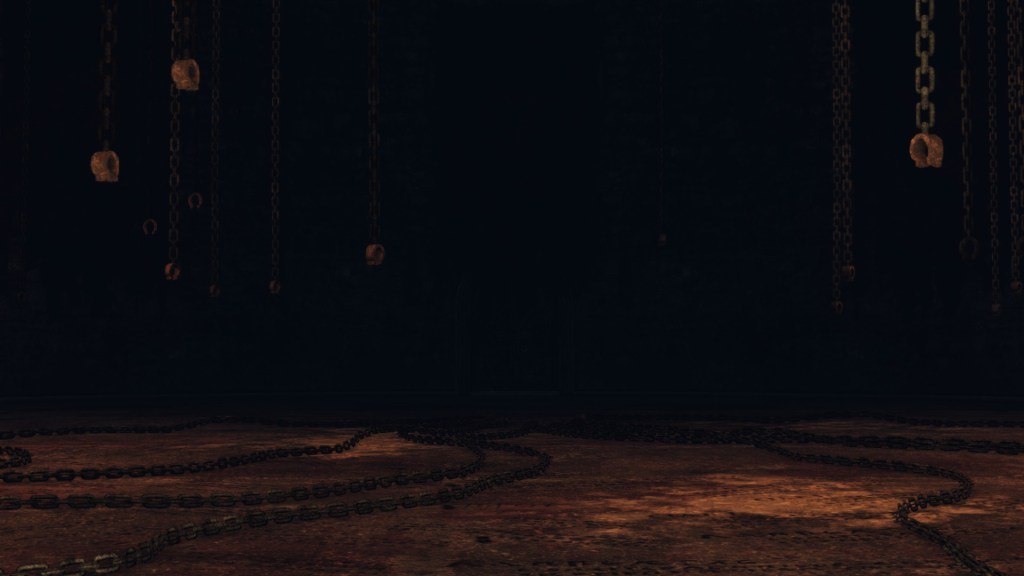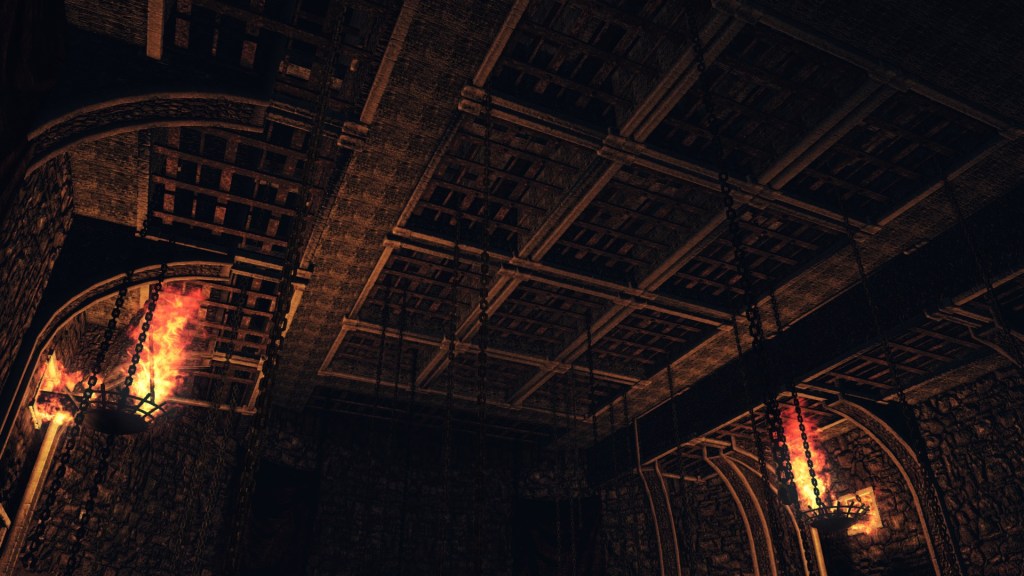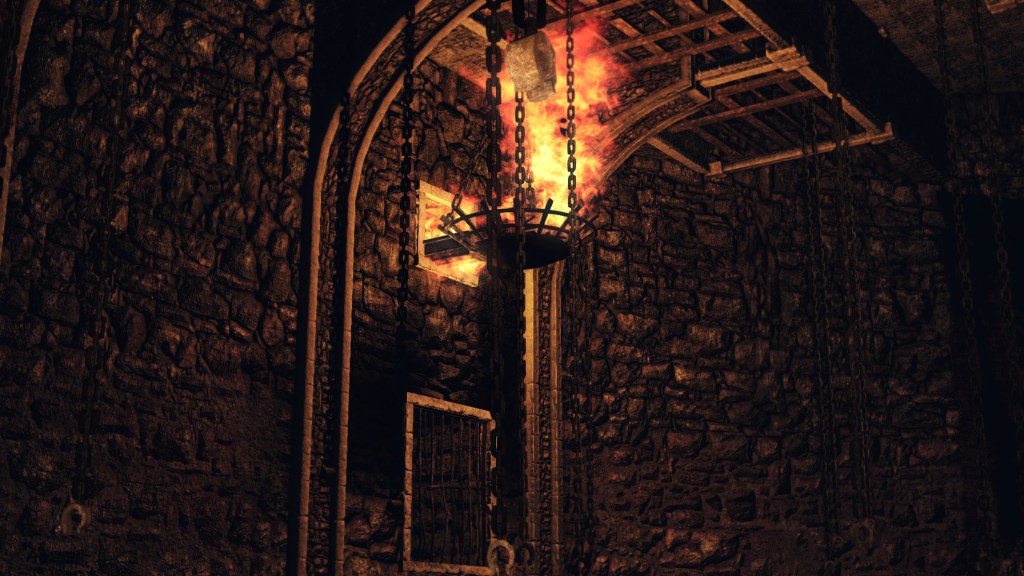Preface
When I first started working on this topic, I didn’t expect it to be as enamored with the subject as I ended up being. Alken and Venn are two kingdoms that have a very simple dynamic fleshed out to an absurd degree, comparable probably only to Drangleic itself. While their duality mostly plays out through the disparate stories of other characters, it all ties back into one thematic whole that brings some much needed cohesion to the narrative and overall setting of Dark Souls II. (DS2) Much of this is thanks to the addition of DLCs and subsequent updates to relevant lore text, which do much of the heavy lifting. But there is no such thing as good writing, only good rewriting. DS2 has received its deserved scorn for lacking these elements on release, especially compared to its sequel Dark Souls III, (DS3) so I am satisfied with the developers at FromSoftware responding to these criticisms and refining the lore for their game at all, even after the fact. The end result is a far more compelling story of two countries than what we started with.

A House Divided
The kingdoms of Alken and Venn, original names Aaken (アーケン) and Vein, (ヴェイン) collapsed well before the events of the main game, but we can still locate their capitals thanks to the bell towers established during their heyday. Belfry Luna and and Belfry Sol were built by the prince of Alken and princess of Venn respectively, in the others’ countries no less. Belfry Luna sits at the Lost Bastille; Belfry Sol, at the Iron Keep. This makes sense so far as both areas are established as royal castles in the past, and it fits on the wider stage as well. The official map of Drangleic shows the Iron Keep and Lost Bastille relatively close, which is appropriate for two countries that share a long and spiteful history together. Although the English description claims both nations were founded by the same man, the original Japanese only uses the term “founder” (祖) with no clarification of this forebear’s sex, making it all the more difficult to identify the individual responsible for creating two different states with such bad blood.

Of course, it is impressive for someone to be the founder of even a single nation, so did this person really establish them separately? Perhaps the countries’ two histories were once one? Put another way, Alken and Venn may have been founded as a single nation that split into two competing states later down the line as a result of some civil conflict. This way, they could both claim lineage to the same founder despite having become different entities. This scenario would also explain the nations’ bitter hatred for one another — a divide in society, culture, and politics could have easily escalated into civil war that ended in a stalemate, forcing both sides to develop into independent states whilst they continued vying for supremacy. Further evidence to this notion is the fact that both the prince and princess create the same puppets to guard their local bell towers from their lover, implying both Alken and Venn share knowledge of this specific art. If the two kingdoms had originally been one, then this comes as no surprise.
Ring of power made in the shape of the choice weapon of Adgarz, imparted as the mad knight of Aaken. Boosts the equipper’s physical attack power.
Aaken and Vein, two countries that once existed in this land, had an intensely hateful relationship despite having the same founder.
We can at least be certain that these nations weren’t around until after the collapse of Olaphis. Belfry Sol’s bell keepers can drop Flame Swathe, one of Straid’s inventions, while Belfry Luna was added onto the existing architecture of the Lost Bastille from Olaphis’ era. However, knowing its place in the timeline still doesn’t narrow down the founder’s true identity. That said, it is possibly connected to Havel. Past Belfry Luna in an obscure corner lies a corpse carrying the Dragon Tooth, the great hammer wielded by Havel and his warrior followers who imitated his equipment in the original Dark Souls. (DS1) Though it does boost resistance to fire and magic, it is odd to find it there when their armor and great shield is found far and away in the Gutter. Does it have some link to Venn?
According to the armor set’s description, conflicting accounts claim Havel to be the name of warriors that wore the armor as well as a country destroyed by war. DS1 affirms the former, but this doesn’t mean the latter is fiction per se. In the Cave of the Dead, we encounter an ancient warrior wearing the Havel set and wielding its corresponding great hammer and shield. This Hollow is dubbed Varg, originally Warg (ウォーグ) in obvious reference to “war”, (ウォー) and he may well be a soldier of this hypothetical Havel nation. Combined with the armor and shield in the Gutter, and there is no doubt that some warriors of Havel or like-minded imitators have resided underground in Drangleic. If there is a nation named after the revered knight of Gwyn, it should be in this land. And yet, we never come across any ruins overtly linked to this supposed country. But, if the country was destroyed by war from within and became two new nations, there wouldn’t be any.

Helmet that is likened to a giant rock. Boasts tremendous defense power while also exceedingly heavy.
The origin of the name “Havel” isn’t known. It is said to be the name of warriors who favored it once or the name of a country that was destroyed by war.
Therefore, it is possible that Havel, one of his warriors, or a similar imitator founded a country in the warrior’s name sometime after the destruction of Olaphis. The founder would need to have an exceptionally high opinion of Havel to name an entire country after him, and the potential of its at least early soldiers dressing in Havel armor would explain the confusion. Stories exist of a country called Havel, but tales of warriors of Havel go back even farther than them, leading to doubt over which is the accurate account. In reality, both existed concurrently and took after the examples of the original Havel and his warriors from DS1. If so, how did a nation founded upon something as solid as rock crumble apart? The Dragon Tooth’s description alone notes the equipment’s resilience fire and magic. Perhaps that reliable protection made Havel complacent to such threats over time, in unexpected ways.
Aspects of Alken and Venn bleed through in the characters of the prince and princess and the bell towers they built. The “sun bell tower” (陽の鐘楼) is found in Alken where the land is bathed in the warm colors of glowing red lava. Meanwhile, the “moon bell tower” (月の鐘楼) is found in Venn where the land basks in the cool blue hues of the night sky and surrounding ocean. Aside from reinforcing the thematic designs of each area, Dark Souls strongly associates the sun with fire and the moon with magic, specifically sorcery. This is fitting since areas within Alken’s territory usually provide pyromancies while areas within Venn’s territory often keep things related to sorcery, mostly works originating from Olaphis. This color and magic dichotomy is emphasized by the prevalence of incense in these areas. Although the Simpleton’s and Skeptic’s Spices aren’t specific to these two countries, notable amounts of each can be found in territories related to Alken and Venn respectively. Perhaps each is endemic to its respective region, but it is certainly fitting that the former is red while the latter is blue.
Each spice is a substance that makes it easier to perform certain kinds of magic through inhaling the peculiar aroma they give off — the Skeptic’s Spice lowering a spell’s faith requirement while the Simpleton’s Spice lowers a spell’s intelligence requirement. These seemingly magical aromas don’t actually improve one’s conviction or reason, just substitute for one’s deficiencies with their particular magic power so that it is easier to perform a given spell. This would imply that Alken was deficient in reasoning while Venn was deficient in faith. This does make sense so far as Venn’s association with sorcery, but Skeptic’s Spice is used for merely hexes and miracles, not pyromancies. Of course, this could be purely for game mechanics, as faith does factor into a pyromancy’s damage. (and later serves as a requirement for pyromancies in DS3) The idea is further supported by the Simpleton’s Ring, which uses some of said incense as its centerpiece and causes the wearer to turn invisible while rolling. Therefore, these magic substances likely have wider applications than what’s reflected in-game.
An ideological rift between the two countries is backed by yet more evidence via items found in their respective territories. Magic items like the Southern Ritual Band and an enchanted falchion can be acquired from chests and corpses at Belfry Luna. Since Venn made the former capital of Olaphis its seat of government, its people likely held a profound interest in sorcery and the lost advanced technology of the magic kingdom. By that same token, the people of Alken founded their capital upon rivers of lava flowing out of a nearby volcano, demonstrating their deep fascination with fire. Fire is considered holy in faiths descending from Lordran, and while Alken’s collection of pyromancies, including chaos pyromancies, can be divorced from religion, the Protective Chime hidden behind an illusory wall of the Iron Keep cannot. This holy bell is used in Lindelt and found in the same area as a Thunder Quartz Ring and a lightning short bow, an element associated with the Anor Londo gods. Add to that a shield associated with Quella in a chest at Belfry Sol, and Alken’s religiosity is undeniable.
Perhaps the collapse of the progenitor nation was a consequence of an irreparable cultural divide between its northern and southern regions. Dark Souls often puts cultures of intense faith in militant opposition to cultures that place reason above it, deeming it heresy. Even this seems to be reflected in the star-crossed lovers’ dynamic. Western cultures have historically associated the sun and moon with masculinity and femininity respectively, making it apt that Belfry Sol is linked to the Prince of Alken while Belfry Luna is linked to the princess of Venn. By extension, Alken and Venn may have played similar gender roles in their poor relations — masculinity has often been linked with aggression while femininity is portrayed as more passive. The two have most certainly warred with one another. The Grand Spirit Tree Shield can deflect spells with a parry, which would be valuable against a nation that primarily employed sorcery. Likewise, its storage at Belfry Sol suggests warring with such a nation was still relevant during the Prince of Alken’s lifetime, and what nation would Alken war with except Venn? However, Alken was probably the aggressor in these military conflicts.
We can acquire a zweihander as well as pieces of the Catarina set in Alken territories. These are weapons and armor associated with knights of Catarina, warriors characterized by their pious, straightforward nature and love for battle as alluded to in the set’s description. Alken may have thus been influenced by the old tales of these knights. Such belligerence is certainly expressed in the Japanese description for the Ring of Blades. The text states that the ring is modeled after the blade wielded by Adgarz, (アドガルズ) the mad knight of Alken, a title synonymous with overwhelming aggression. One of Alken’s territories is also the site of the Altar of Sunlight dedicated to Gwyn’s firstborn. Even though the war god’s effigy has broken like his altar in DS1, the sunlight medals acquired from enemies in the area confirm he was worshiped in Alken and thereby promoted a bellicose society. That being the case, any civil war and subsequent conflict would likely be prompted by Alken against a defending Venn, which was apparently more interested in intellectual pursuits than invasion.

History, culture, society — all of these aspects appear to be deeply intertwined with each country’s most prominent citizen and the bell towers their love produced. But more than that, they reveal the lineage of two tribes shaped by their geography, straying from their bedrock of solidarity into disparate camps focused around either fire or sorcery. If Havel is the progenitor nation, then a lot of these developments make all the more sense. But even if it is not, there are still very overt associations between each kingdom and their most prominent royal. In fact, they are the only notable characters explicitly confirmed to be from those nations. And so, we can be certain that the narrative for these two countries were very much written around their prince and princess, making their story the story of their kingdoms.
Love Never Meant to Be
The prince and princess most likely first met on the battlefield. The prince at least already had a mighty soul, which is common among great warriors. And with the two countries constantly at war, he must have frequently led troops into battle, where he came face-to-face with the enemy commander. Regardless, they ultimately entered a clandestine relationship. To immortalize their bond, the royals each constructed a bell tower at the other’s castle. How they managed to fund these projects without the opposing families discovering the true backers is never clarified, but they were both adamant to protect their sweetheart’s gift from any intruders. This prompted each to create puppets commanded to slay any who approach the bell and ring it, a job they have done and will continue to do so long as they are able. This is the basis for the Bell Keepers covenant and demonstrates the depths of their love.
Aside from an army of puppets, Belfry Luna is additionally guarded by gargoyles. According to their soul’s Japanese description, these stone statues were specifically built at the bell tower and so don’t predate it. Furthermore, the English text’s claim that they “mysteriously came to life” spontaneously is more accurately worded as “one day came to possess life” in the vaguest terms. In order to possess life, one must have a soul. In other words, these statues were given souls much like the puppets guarding the bell towers. And with the timing of their construction, it is no mystery as to why. The princess of Venn probably built these gargoyles to serve the same role as the puppets she created. The description for the Gargoyle Bident implies that it is part of a long tradition of defending castles and forts with such elaborate statues, well predating the two warring kingdoms. Even their weapon is a reproduction of the spear mentioned in some ancient book the princess apparently referenced.
Soul of a gargoyle of the Forgotten Prison.
The splendidly crafted stone statues were made at the bell tower, and one day they came to possess life.
The special soul this living stone statue possesses is used to acquire a vast amount of souls or create a great power.
Two-pronged spear reproduced based on old books.
Gargoyles are considered beings that protect castles and fortresses from curses, and various kinds have been made in countries of successive generations. It is said that some were elaborate enough to look like they were things that were alive.
Indeed, the fact that both Alken and Venn are able to install souls into artificial constructs to create living automatons suggests they inherited the art from the progenitor nation. But where did that nation inherit it? Olaphis? But its origin would have to go back even farther then that if we are to believe the bident’s description. The art of crafting golems and gargoyles was originally mastered by the gods of Anor Londo, and we can see that this knowledge had been carried on by Heide. The gargoyles in DS2 using similar fire and lightning attacks as DS1’s gargoyles, not to mention the same boss music, only reinforces this notion. Moreover, the gargoyles of DS2 have been traditionally created to protect castles and fortresses against “curses”, not just “ill fortune” as the localization asserts. This is an obvious reference to the gargoyles from DS1, which protected Sen’s Fortress and the castle of Anor Londo from the cursed Undead attempting to pass through them. It is very likely then that these elements of Anor Londo culture survived Heide’s destruction, either passed down or rediscovered by subsequent nations like Venn.

While this explains why both the prince of Alken and princess of Venn could craft these puppets, it doesn’t explain the existence of the Bell Keepers covenant. Members are given a ring emblazoned with the seal of a bell which allows them to be warped to one of the two bells as a grey spirit whenever someone approaches them. And after the trespasser is slain, the puppets ring the bell as they have done since their creation. Why recruit outsiders at all? The lovers clearly didn’t want anyone approaching the bell towers, and yet the puppets’ request for help from visitors and these rings’ function encourage just the opposite. Was this truly part of the puppets’ original mandate or an independent decision they made long after the deaths of their creators? Should it be the latter, then what purpose did the rings serve originally? And why be so defensive about anyone entering and ringing the bell? Most likely, it was the lovers’ secret rendezvous point.
The royal sweethearts cannot be hiding the existence of the bell towers since they are visible and audible to anyone in the vicinity, nor can they be protecting them from random destruction. That just leaves hiding something within them, which is supported by the Bell Keepers providing Hidden Weapon as a covenant reward. However, what is there to hide beside the love the prince and princess secretly shared? And what evidence is there to find in an otherwise unassuming bell tower? Perhaps none now, but at the time the puppets were created it may have been the site of clandestine meetings. The seal is designed to summon the wearer to the location of the nearest bell tower that a human entered, perfect for the prince and princess to meet up in secret. At the same time, it would be disastrous if someone else saw the royal of an enemy nation warp in right before their eyes, so guards were created to prevent trespassers. The regular ringing of the bell is an all-clear signal for the prince or princess to put on the ring and await their beloved’s visit. This is why the covenant keeps trespassers from ringing it; it prevents false flags.
Of course, there is no point to the Bell Keepers’ mission after all this time. Both Alken and Venn have collapsed, and the prince and princess are unlikely to still be having any secret trysts. However, these puppets are essentially magic automatons and thus bound to follow their programming. As item descriptions poetically allude, the two’s love for each other which motivated the puppets’ creation binds them to protecting the symbol of their love for all eternity. These dolls are not operating on true logic so much as what is within the parameters set by their creators. If not commanded to not recruit outsiders even as the number of broken puppets pile up, they won’t. And until commanded to do otherwise, they will continue to enact their original duty. In this way, the Prince of Alken and the Princess of Venn’s eternally unfulfilled love is also a curse. But curse or no, something did happen to the prince and princess and the kingdoms they represented. For the Japanese description of the Bell Keeper set doesn’t refer to them as Prince and Princess, but King and Queen.
Old helmet that is deceptively comfortable to wear. Personal effect of the bell keepers.
The secret love of the former King of Aaken and Queen of Vein binds these small puppets even now. Even though the King, the Queen, and their countries are already lost now.
Evidently, the lovers had eventually become leaders of their respective nations following their predecessors’ deaths conveniently around the same time. This comes with the implication that they married different partners per their royal duties, though it is possible for the princess to have assumed the throne by herself if there were no other legal claimants for her to compete with. However, this political reality didn’t necessarily end the love affair or at least the mutual pining. The fact that the bell towers and their guards remain indicates that neither had the resolve to give up so long as they were both willing and able to do so. Key words, willing and able. We cannot confirm that the King of Alken and Queen of Venn are actually dead. The Japanese description broadly asserts that the king, queen, and both their kingdoms have been lost. Does that mean they are both dead or just no longer King or Queen of a country? Did they turn Undead and hollow after their countries’ collapse? When and how did their countries fall apart?
Forged by Iron
The Old Iron King was a “weak” king lacking in wealth and power until he obtained the iron that was located in Venn. This alone proves that this king whose name has been lost to history was a contemporary figure in the histories of Alken and Venn. Moreover, Belfry Sol is located at his castle, meaning that the Iron Keep was likely built directly on top of the capital of Alken. This implies that the Old Iron King was in fact a king of Alken. Mytha’s manakins are created with the same art of puppetry used in Alken and Venn, and Gilligan recounts her marriage to the ruler of the castle “beyond” the Earthen Peak, namely the Iron King in the Iron Keep. However, Gilligan also claims that Mytha’s husband was originally in love with someone else, which lines up perfectly with the former prince of Alken’s forbidden romance. And so, the Old Iron King and the later King of Alken are undoubtedly one and the same.

Iron rod tinged with strong heat. Gives heat to the Tower of Black Fog and is used to operate devices.
The Old Iron King who plundered this remote region from the Kingdom of Vein was a weak king. But he became the king to rule this land thanks to finding this place where iron is born.
Why then was the new King of Alken so weak? It may have been a result of Alken’s aggression. If a kingdom constantly invaded its neighbor since their two countries’ inception but failed to either conquer the opposing kingdom or make any noticeable progress against them, the stalemate would inevitably tax their coffers. Basically, Alken’s endless onslaught wasted wealth and resources throwing itself into a brick wall until its offense finally burned out. Indeed, that the Prince even became King suggests disaster befell the previous monarch. This would greatly diminish Alken’s military strength and threaten its royal family’s hegemony over its territories. What would stop infighting by self-interested noble factions from further destabilizing the kingdom? The King of Alken needed some saving grace to consolidate power around his central government and turn things around, and he found that in the form of foreign aid.
A strange “knight” from the far East was visiting the Kingdom of Alken and apparently demonstrated his fighting prowess, as it caught the feeble’ king’s attention. He begged the foreign warrior to train his soldiers in his people’s unusual fighting style. The stranger, for his part, apparently saw the man’s potential to be a great king, accepting the task and ultimately deciding to serve as the monarch’s knight. Alonne had made a name for himself as the Iron King’s right-hand man and most trusted counsel, having contributed to his lord’s acquisition of the throne. This explains why the Eastern warrior’s name is originally “Aaron” (アーロン) in reference to the Japanese spelling of the English “iron” or airon. (アイロン) A weak king placed his faith in a stranger during his hour of need, and his desperation was rewarded. With Alonne’s help, Alken turned its bleak situation around.

Soul of the knight Aaron, who once served the Old Iron King.
It is said that Aaron, who came from an eastern land, was the one the King had the most faith in.
The special soul this knight possesses is used to acquire a vast amount of souls or create a great power.
Based on the Scorching Iron Scepter’s description, the king had discovered massive iron reserves in Venn, which we can witness throughout the Iron Passage. Perhaps Alonne noticed this during his travels and relayed the information to his new lord, but it wasn’t as if he couldn’t have learned about it on his own. Surveying the geography reveals a rocky terrain similar to the mountain range Alken’s capital is situated in. Likewise, pools and rivers of lava dot the entire surrounding region, whereas said capital sits on a lake of magma visible upon a distant highland from Harvest Valley — comparable to a caldera lake on a plateau according to the game’s director Yui Tanimura in the Dark Souls II: Design Works interview. Although this still doesn’t justify the nonsensical lift up to the Iron Keep from the valley’s Earthen Peak, Tanimura later confirms that Brume Tower is, in fact, an extension of the same place.
We can therefore assume that this so-called remote region was still relatively close to the King of Alken’s castle, on the border even. A corpse in Brume Tower carries the Simpleton’s Ring, worn by warriors that received the king’s “divine protection” when they departed for the front, making the future tower’s location the edge of enemy territory. This is reaffirmed by Magerold, who states that the castle’s fine quality iron was harvest from “this area” while staying there. Being a borderland also helps explain the relative ease in Alken plundering its resources. It was the perfect target with the perfect solution to the new king’s perfectly hopeless situation.
Ring made in the shape of a fool’s flower. Form becomes invisible while rolling.
It is said that warriors who received the divine protection of the Old Iron King wore it when departing for the front.
Wonderfully fine iron can be harvested from this area.
Once Alken invaded and conquered the territory, towering facilities were built to mine, smelt, and forge the iron there. These towers’ architecture employ the image of blossoming flowers and the sun in their iconography, holy icons that were used to symbolize fire in DS1. This makes it far less likely for this iron factory to have been constructed by Venn versus the more overtly religious kingdom of Alken. Furthermore, Venn’s implicit ignorance about its own iron reserves explains why it failed to prevent this conquest. They simply didn’t know the value of the otherwise barren land and so didn’t adequately defend the border. That isn’t to say the kingdom ignored Alken’s invasion. Several items related to sorcery can be found at Brume Tower, including the Dispelling Ring created by Straid. This indicates that Venn had tried and evidently failed to take back lost ground. It is no mystery why this region had become so critical for both countries either. Controlling the iron was a matter of both economic and national security.
Iron is, of course, essential to a medieval society’s military prowess. The Iron King’s knights wore iron armor and wielded steel katana, which were “beautiful” and “solid” thanks to the excellent casting techniques of his new iron facilities. And with an abundance of iron to spare, Alken was capable of mass producing arms and armors as showcased by the various different weapons accoutrements found throughout the ironworks. Both the Strength and Dexterity Rings are malformed iron bands imbued with the metal’s “divine protection” that would help give the Iron King’s soldiers an edge in combat. More importantly, their shoddy craftsmanship shows a willingness to experiment with this surplus of iron, and something can be seen with the melted iron axe that became the Smelter Hammer. As the rings’ descriptions relate, the King now had the power to freely transform iron as if he were creating life — in some cases, pushing the limits for the actual creation of life.
Curiously warped iron ring. Increases the physical strength if worn.
The Old Iron King amassed a great age via the divine protection of iron. That power was used to freely transform solid iron as if it was the creation of life.
The ironclad soldiers are iron golems the Old Iron King crafted with iron for the soul’s frame. Such heavy iron soldiers are a huge step up from the puppets of Belfry Sol and make for a far more formidable opponent than your common soldier, but they weren’t even the end goal. As we explore Brume Tower, we see chains raising and lowering frames of the old knight golems created by Heide. The Iron King had apparently been attempting to recreate the ancient country’s mighty puppets. A corpse found in the Harvest Valley also carries their pike and great shield, reaffirming this implication of prior research. This explains why the Full Moon Sickles used by Alken Undead of the Huntsman’s Copse are made with bradden steel, a metal derived from Heide’s similarly special alloy — it also proves that Drangleic wasn’t the first to try reverse-engineering that mysterious metal. That said, the lack of active Heide golems in Alken lands and bradden steel in Alken wares suggests that they had only just started manufacturing them when the ironworks halted production completely.
Even so, the fact that there we can draw a continuous line from the Iron Keep to the Huntsman’s Copse, which is linked to the ring temple leading to the Heiden ruins, gives Alken a pathway for investigating this civilization. There is only one problem: it completely surrounds the Lost Bastille over land. Considering that Venn bordered so close to the Alken capital, it is hard to imagine the former permitting the latter such a massive territorial advantage during its period of weakness. Therefore, the territory spanning Huntsman’s Copse to Earthen Peak must have belonged to Venn originally. Indeed, the Copse is where moonlit butterflies are found in abundance. Considering the forest’s adjacency to the Lost Bastille on the map, it is likely an extension to the remnants of Seath’s archives, unmolested by civilization and thus still a major habitat for the living works they brought with them. That would also make the area more than close enough to have been Venn territory initially. In fact, its holdings must have extended as far as the Shaded Woods given that the Bell Keepers knows a recreation of Oolacile’s Hidden Weapon spell.
But after securing the iron at Brume Tower, Alken pressed the offensive north and then west to conquer these territories, gradually boxing Venn in. The lonesome shrine to Gwyn’s firstborn had likely been built when the Harvest Valley was just a battlefield to this end. Once the battle was won and they no longer needed to petition the war god for aid, the Alken army pushed onward and left the Altar of Sunlight to be forgotten. The land changing hands is reinforced by the presence of a corpse with the text recreating Oolacile’s Chameleon spell when the valley is situated just beneath the Shaded Woods on the map. This would likewise explain why Alken looks to have only just begun replicating Heiden golems before its collapse — it took time to establish that territorial land bridge. In that case, the only thing that actually stands out in the kingdom’s sweep over these periphery lands is, of course, the remaining heartland.
There is no evidence of subjugating the Lost Bastille, taking all of Venn’s holdings along with its capital outright. Instead, Alken seemed to have deliberately avoided striking directly at its age-old foe. Why? The obvious answer would be the Iron King’s affection for the enemy Queen. Perhaps this small mercy was his gift to her for their eternal if unfulfilled love; he may have even been returning the favor. After all, why hadn’t Venn taken advantage of Alken’s previous weakness? Was it not the perfect opportunity to rid themselves of their nemesis once and for all? Maybe they were just that dedicated to their intellectual pursuits. But if its Queen, partial to Alken’s new king, had lobbied against a counterattack and sued for peace, then this gave the ample opportunity for Alken to make its comeback. Now Venn was essentially under siege and would never threaten the Alken heartland again. The Old Iron King would at least leave her and her home with their pride as an independent nation.

Whatever the case, these huge strides in technology and territory show just how major the massive iron reserves really were. But even that paled in comparison to their economic impact. Any country that mined such a huge supply of iron would see its price plummet within its borders. Production of not just military wares but general products would become dirt cheap, and the rest of the surplus would be used to make the country a major exporter. And since Alken’s royal family personally owned these iron mines and factories, it reaped all the rewards of these sales. In one fell swoop, the Iron King stimulated his country’s economy, expanded its border, acquired the means to defend his assets, forced the dependency of his holdings’ governing nobles, and amassed a swift and tidy fortune. This was the political calculation behind a weak king invading Venn, and Alonne was invaluable in this effort whether his contribution was drilling, apprising, fighting, or strategizing. And it all paved the way for a golden age built on iron — so much iron that excess amounts were used in the various doors, keys, and ornaments created during his reign.
Drown in Decadence
Perhaps because of its importance, the Old Iron King personally oversaw the whole creation process. The main tower we explore is divided into five stratums, with throne rooms located at both the top and bottom floors. This indicates that the monarch at least made regular visits to the facility, allowing him to supervise production from the gears moving iron production to the residue piling up at the bottom. These personal chambers may have also been a necessity in the event that Venn came to take their land back, which would require he take to the field and setup a base there anyway. All that said, the practicality of it may have been overshadowed by the king’s artistic whimsy. Shalquoir ponders whether all humans’ tendency to show off reflects a desire to be beautiful, specifically mentioning the “unsightly” iron castles they build in pursuit of that end. This is an obvious reference to the Iron Keep the Iron King constructed, and implies that his involvement in production was motivated as much by his sense for aesthetics as anything practical.
Do you think all humans want to become beautiful? Cats are beautiful from the outset, though. Heh heh heh. They want to display themselves… That’s why they make such unsightly iron castles and don’t realize the ugliness of their deeds. But, points like that’re cute though. Heh heh heh.
The Iron Keep is specifically a “melted iron castle” (熔鉄城) in reference to it sinking in lava to varying extents. The term is localized as “smelter” in other instances and uses the same kanji as “molten” iron, (熔銑) so it refers to iron that has been in some way affected by flame. It isn’t the castle’s official name, but is nevertheless the one that Iron King built, though how much so is ambiguous. Despite the name, the vast majority of the area is comprised of stone and marble, not iron. And considering the continued existence of Belfry Sol, it is possible that the Old Iron King simply built upon the existing architecture, renovating Alken’s original palace with new iron adornments. Given the importance of religion in Alken, the statues of robed men either orating with an open scroll or clasping their hands in prayer lends further credence to this idea.
But whether his new home’s construction was conservative or radical, the king made sure to display his newfound power both literally and figuratively. The castle’s walls and furniture are often decorated with symbols for strength, power, boldness, and courage. These include statues of griffins and ornaments of lions, but the most pervasive is images of bulls, so much so that an iron bull arguably emblemizes the Old Iron King’s reign. Collectively, the icons found there and at Brume Tower convey an image of dominance contrasting his prior weakness as king. Was this warranted? His past political and financial vulnerabilities clearly made the him feel insecure no matter his aptitude as a warrior. From his perspective, he needed to project strength, at home and abroad.
Besides iron arms and armor, his forces also associated with the Bound Wooden Shield, which bears the image of a lion. The enemy needed to know that his kingdom was a formidable player on the world stage. After reaching the Iron Keep, we need to cross a bridge before entering the actual castle. Along the way, we pass under an archway inlaid with the aforementioned statues of robed men, only they have been wrapped in chains pinned with swords. Chained cages also hang over the lava moat on either side of the bridge. Both of these trace back to the same source: another statue holding the “reigns” front and center atop the arch. The meaning would be clear to any visitor, and whether political dissident or prisoner of war, the message was the same: in this king’s domain, iron rules, and he is its sovereign.
This propaganda extended to his private life. As his cavalier use of iron swords at his doorstep would indicate, the Old Iron King collected many weapons merely to exemplify his authority. This hobby might seem excessive, but what real harm was there in amassing fancy arms befitting a rich warrior like himself? As the Covetous Gold Serpent Ring found at the castle elucidates in its description, only a coward would miss out on a good opportunity simply for fear of the danger, and there was none yet. However, these small indulgences snowballed soon enough. The man wanted to make himself look better by trumpeting the power and riches he adopted, so his greed continuously fed into his own ego until it was nothing but excess.
The Japanese description for the Ironclad Helm notes that the Old Iron King had at one point approached the “profound mysteries” of the soul the same as Vendrick and Aldia after him. This makes sense so far as he alone had both the knowledge and resources to investigate the nature and origin of the soul through the golems he was creating. Had the man considered the deeper implications to the power behind life, he may well have discovered the Throne of Want and become a Lord of Cinder. Instead, he drowned in the pleasure his vast fortune afforded him. Aside from boasting the depths of his coffers and the strength of his ironclad army, the Old Iron King had apparently tried creating an iron dragon. We do find plenty of petrified dragon bones and somethings in his castle, with more at Brume Tower. There is no sign of an actual iron dragon, but it is very revealing about where the king’s priorities lied.
Helmet of heavy iron soldiers. It is terribly heavy for its high defense effect and requires considerable power to move decently.
The heavy iron soldiers are puppets that were created by the Old Iron King and move via the life of ones infused with souls.
That Old King who once had a mighty soul approached its profound mysteries at one point, but fell before his vast fortune and drowned in pleasure. He ended up becoming a vulgar person.
Dragons are associated with strength thanks to their resilience and might. While there may be value in researching the nature and origin of these qualities, replicating a facsimile with iron serves no purpose other than to produce yet another symbol of the king’s power. Indeed, while concept art only depicts vague brushstrokes, his knight captains in-game have the dragon crest featured on Yorgh’s Ring plastered across their oversized shoulder plates. The same is true for the Yellow Quartz Shield native to the Iron Keep. The dragons’ significance certainly wasn’t lost on the monarch, pious Alken likely inheriting the symbol from the religion which Yorgh inadvertently spawned. But the iron dragon itself would bring the Old Iron King no closer to the truth of the soul. There was no deeper contemplation of the power he toyed with, just shallow and uninspired shells to house it.
Key that opens the door of the Tower of Black Fog.
Much iron was born from the tower once. The king made soldiers of iron and built a castle of iron. And it is said that he even tried producing a dragon of iron.
This superficiality extended to the Old Iron King’s personal relationships, too. As noted before, the kingdom’s prosperity allowed him to invite various dubious guests from foreign lands into his court. This openness may have come from past experience, but the fact that it was specifically his opulence that attracted them proves how misguided he was. Many of these foreigners were charlatans, all too happy to feed the Old Iron King’s ego in order to earn his favor and maybe a smidgen of his assets. Only a few actually contributed anything of value to his kingdom, the most notable of which is Eygil. This pyromancer is the only named individual known to have served the king besides Alonne, implying that he was held in a similar standing to the trusted knight. The spells he created are only found at Brume Tower, so if nothing else, he was definitely a legitimate spellcrafter. More importantly though, their location is proof that he was present in the king’s precious ironworks.
Eygil had more than likely curried enough favor with the Old Iron King to be entrusted with managing the iron facilities in his lord’s absence. The monarch did need to run a nation, or at least wanted to bask in the comfort and luxury of home. Likewise, Eygil’s presence there and use of pyromancy indicates that he was more interested in using an iron furnace than joining the king’s exotic company. Therefore, putting him in charge was the most logical decision; that doesn’t make him any different, of course. The massive iron bull statue ornamenting the Iron Keep is dubbed “Eygil’s Iron Statue”, (エギルの鉄像) meaning that he was the one who produced and gifted his lord such an oversized icon. This feat would be impossible without access to the kingdom’s ironworks, and the lever inside controls the flames other bull constructs flare out throughout the whole castle — he was in charge of all things fire-and-iron-related. It shows that even the King’s most competent retainers knew to tickle his ego to get in his good graces, and it worked.
All of this debauchery must have brought Alonne no end of frustration, horror, and disappointment. This was no longer the noble, lovestruck king he chose to serve. He saw money and power turn him into a depraved, corrupt hedonist hellbent on wasting away his life in the lap of luxury. What was the point of helping the king achieve that prosperity? What was the point of him even being there? Perhaps it was to try putting his lord back on the right path, but whatever attempts Alonne may have made to advise the Iron King, they evidently all failed to convince him to reform. As Shalquoir infers, the monarch didn’t realize how truly ugly his actions had become beneath the superficial glamor. In his strive to improve his image, he instead ended up becoming more vulgar than ever. And after a certain point, Alonne just gave up on him, deciding to leave his lord for a new land when his master’s kingdom had reached its zeitgeist — or at least, he should have.
Helmet of the knight Aaron, who served the Old Iron King.
Aaron, who came to this land from the east, once chose the power-weak Old Iron King as his master and contributed to his acquisition of the throne.
However, it is said that he left to seek a new land when the King’s power reached the height of prosperity.
After we acquire both the Ashen Mist Heart and the Iron King’s crown, the latter seems to react to Alonne’s sword and armor set up in a kind of display room beneath the topmost throne of Brume Tower, triggering a memory residing in the crown. If we enter the world of that memory, we will find ourselves at the Iron Keep, which we can identify based on the identical architecture and presence of the castle’s knights. This is a part of the castle we cannot explore in the present era, presumably the portion which we see has completely collapsed into the lava and become the Old Iron King’s boss room — only the teleport point granting easy access to Brume Tower remaining. Indeed, the boss room for the memory is an antechamber to another throne room, flooring a shiny marble reflecting the twilight clouds outside the arched windows; the iron throne in the next room identical to the one half-buried in ash at the bottom of Brume Tower.
However, in order to reach this throne, we must fight through not only knights and salamanders — which the King apparently kept as pets — but even Alonne. The boss is formally sitting on the floor when we enter the antechamber and immediately engages us in combat. If we happen to defeat him effortlessly, he will commit seppuku to atone for the dishonor, but we undoubtedly cause the death of the knight who had supposedly left on a new journey regardless. This apparent contradiction is unlikely to be a developer oversight since the description for the Alonne Knight Captain set reiterates his loss of faith and departure following the big fix. We undoubtedly travel to a period when the Old Iron King was still alive and recently present in the area. In fact, the smelter wedge left on his throne suggests that the king had only just returned from the ironworks. So why is Alonne there?
Helmet of the Aaron Knight leaders.
Those Aaron Knights who served the Old Iron King dressed themselves in beautiful and solid equipment that was born via an excellent casting technique.
Its design resembles a strange knight who once imparted his techniques to the iron knight order but gave up on the fallen king and disappeared.
Some might suggest that our actions simply change history, but this is inconsistent with how every other use of the Ashen Mist Heart is treated in-game. In fact, the presence of Alonne’s unique armor and weapons at Brume Tower implies that his death at the Iron Keep is part of yet another time loop scenario. Perhaps Alonne did leave for foreign lands only to later return to the lord he abandoned in an attempt to reconcile, awaiting a formal audience with the king only to die just before they could have a proper reunion. It is at least reasonable for his close relationship with the king to give him seconds thoughts about labeling him a lost cause after the two spent some time apart. And his lord seemed to want him back.
Alonne’s departure prompted the Old Iron King to name the knights he had trained after him. And following his death, the monarch had taken his weapon and armor and enshrined it below his throne at Brume Tower. Perhaps he intended to make it the basis for future designs with plans to update the Alonne Knights’ equipment, but it nevertheless demonstrates his care and respect for the man who helped prop him up. Reinforcing this, Nadalia has his crown while sitting upon his lowermost throne at the ironworks, as if the monarch left it behind feeling unworthy of its weight alone. That being said, Alonne’s tragic death wasn’t enough for the king to mend his hedonistic ways. If anything, the grief might have driven him to drown deeper in the pleasures debauchery afforded him.
Katana created from the soul of the knight Aaron. Are the ripples that almost bewitch people a kind of bewitched blade?
Aaron visited from the east and made a name for himself as the Old King’s right-hand man. After he left, the Old King gave his name to the soldiers born from iron.
Corrupts Absolutely
As we explore the king’s castle, we come across blast furnaces, iron smelters, and even platforms to lower into the lava. He clearly turned his home into a factory, but why? Brume Tower fulfilled all his needs, so what was there to manufacture there that he couldn’t create elsewhere? The answer is his ultimate creation. The Smelter Demon was to be another of the Iron King’s golems, only this puppet would be forged with the lava the castle stood upon. He likely wanted to imbue both body and soul with the power of fire which the magma radiated. Its two halves are connected by a spinal column far too thin to support the weight without the help of the flames blazing in the gap, suggesting it intrinsic to the design. By using lava to construct the frame and power the core, the puppet’s resulting strength and agility puts even Anor Londo’s Iron Golem from DS1 to shame, and that in itself was probably the goal.
Extra large sword created from the soul of the Melted Iron Demon. The blade keeps the power of a fierce fire. Unleash its hidden power via a strong attack.
The Old King who acquired the power to give life to iron manufactured puppets of various forms. This iron mass may also be of one of them.
Like the Old Iron King, the Porcine Shield is worthless for its expected purpose, only reminding onlookers of greedy, gluttonous pigs. Conveniently, it is part of his weapon collection, stored within a chest right after the Smelter Demon. Kept with it are a bunch of flame butterflies, whose firepower we use to light a torch. Taken together, bringing the lava golem to life was to be this insatiable king’s greatest extravagance, the crown jewel of his debauchery. In fact, considering the horns and claws unnecessarily included in the design, this puppet might be the iron dragon he had been working towards. Indeed, the gaping hole for a face could easily facilitate fire breath, and Venn’s gargoyles prove they knew how to imbue a mineral body with fire to recreate those circumstances for dragons. If the idea was to create an iron dragon which retained the form and fighting prowess of a man, then this was undoubtedly the king’s most ambitious, and excessive, project yet.
It comes as no surprise then to encounter a prototype at Brume Tower, nigh identical to the frame found in the Iron Keep but looking significantly older and embodying blue flames of a magic nature. The magic power was likely intended to substitute for that of the lava and serve as a proof of concept for the golem’s design. As to its origin, Eygil was the probable caster. Although we can only acquire his pyromancies, the man himself is never actually called a pyromancer. Instead, he is identified by the much vaguer term “arts expert” (術師) at the root of both “pyromancer” and “sorcerer”. Eygil may have been fascinated with fire, but that doesn’t limit him to just one school of magic, especially considering how often sorcery and pyromancy are taught in tandem in the New World. And this magus certainly had motive for contributing to this particular project.
Pyromancy created by Eygil, caster who served the Old Iron King. Fire many fire pillars in front of the caster.
Eygil sought something resembling a will for fire. For example, the name “fire snake”, due to it wriggling like a snake that bites its prey, is a vestige of that.
Eygil wanted to imbue fire with at least the appearance of a will, essentially making the flames look as if they were alive. This is why he dubbed one of his spells “Fire Snakes” after its flames’ resemblance to wriggling serpents biting at their prey. The concept is feasible with humanity, but Eygil was apparently only just beginning to see the potential of the Dark arts. While still dealing fire damage, his Dance of Fire resembles the dark pyromancy Outcry in both its actual flames and menu graphic. (Carthus would later complete his research in DS3) That being the case, directly imbuing a soul with fire power so strong it melts rock, encasing it in a suitable shell, and then inducing a will in it sounds like the next best thing. It may even be that the Old Iron King had gotten the idea to create such a golem from the spellcaster. But regardless of whether Eygil had lobbied for it, it is hard to believe that the man didn’t know about or participate in the Smelter Demon’s creation. The older model encountered in the tower he oversaw had apparently wandered into the mines if not been stationed there, after all.
With the prototype a success, they could move onto the final product. The golem’s iron frame was completed, its core was set within it, and its body was submerged in the lava. Whether this event was intended to spark the soul’s will or just imbue it with fire power and be brought to life at a later date, things don’t go according to plan. The fire at the bottom of the earth responded to this new element, causing a chain reaction. The Smelter Demon sprung to life and gushed out of the lava along with a surge of flame. In a single swing of its blade, the beast killed its creator with the very fire he thought to control. The chest in the Iron Keep containing Chaos Storm highlights the irony; the pyromancy’s description makes the Witch of Izalith into an allegory for those seeking power beyond their means inevitably being consumed by it. The text for Immolation, acquired from a Belfry Sol chest, ponders a similar sentiment: nothing will stop someone from acquiring what they want, even if they get themselves burned.
Helmet of the Melted Iron Demon, an iron mass that possessed life. Has high fire defense power.
The Old Iron King acquired a vast fortune via an abundance of iron, but was burned by a fiend that was born from among the fire at the bottom of the earth.
Extra large sword created from the soul of the Melted Iron Demon. The blade keeps the power of a fierce fire. Unleash its hidden power via a strong attack.
The fiend that appeared from the fire that gushed out from the bottom of the earth burned up the foolish king with one swing, and then the castle was swallowed by fire.
The king’s death wasn’t all, though. The surge of magma had destabilized the Iron Keep, causing the whole castle to sink beneath the weight of its iron. What few parts of the castle we can still explore stand lopsided or flooded with lava. And floating on this magma is a chest containing the Phoenix Parma, which apparently lost its original color as a result of the gushing fire. We can thus be certain that much of the castle’s lower levels have been submerged in the molten rock, though Magerold’s secondhand account of the incident suggests that the castle was already gradually sinking from its weight even before the fire swallowed it — it was just the tipping point. Nothing speaks more to the Old Iron King’s hubris than the castle showcasing his glory being swallowed by the earth he was convinced would be conquered like the rest. But for all his arrogance, Alken still owed its resurgence and prosperity to their debaucherous king. The Alonne Knights at least seemed to recognize that fact, for their loyalty was “even stronger than iron”, and this led all of them to follow their lord to their graves.
Small shield with a bird seemingly resembling fire engraved into it.
It was swallowed by the fire that gushed out from below the Melted Iron Castle and its original color has been lost. But strangely enough, the shield itself is somewhat unharmed.
So, some former king made the castle here with that iron. Then it somehow became a little too heavy and gradually sank the castle. After that, fire gushed out from the ground and, with that, it became what it is. Well, it is a secondhand account though. Did it tide over your boredom? So? Buying something? Anything?
Helmet of the Aaron Knights.
The Aaron Knights who served the Old Iron King were tied by bonds even stronger than iron. And so, they were ultimately swallowed by fire along with the castle.
As the melted iron castle sunk, the Alonne Knights stayed behind to be swallowed by fire, perhaps inspired by example. Several Black Knight weapons can be acquired at the Iron Keep, with their wielders implied to still be remembered as servants of the King of Light in the descriptions. The Black Knights had also shared in their lord’s demise by fire out of loyalty, and the parallels don’t end there. Although the knights guard the castle to the present day, they are unaffected by Soul Appease and so not Hollow and probably not even Undead. Instead, they were scorched by flame, hence their armor is dull and dirty in contrast to the shiny and clean variant found in the game files; it also possesses notably higher fire resistance. More than likely the Alonne Knights faced in the Iron Keep are just their strong wills animating their equipment after their bodies had burned to ash, the same as the Black Knights. Some might argue that they can suffer from bleeding and poison, but so did their predecessors.

Intended emulation or not, the Alonne Knights’ similarities to the Black Knights extends to their respective lords as well. Shalquoir alludes to a resemblance between the gaudy conceit of the Iron King and the vanity of Gwyn, and the connection isn’t limited to their personalities. After his body and soul were swallowed by the earth, the deceased King encountered the soul of the ineffable Gwyn at the bottom and was possessed, twisting him into the demonic giant lurking beneath the surface of the molten rock lake prior to our arrival. The Great Lord’s presence there isn’t as random as one might think. Ask yourself: Why did the Old Iron King lose control over the Smelter Demon? Why did the lava react to his experiment? Why did he want to acquire the power of lava? Why was the capital of Alken founded upon a lake of lava? Why did the resulting country based around lava skew toward faith? All of these questions can be answered by the lava being a byproduct and extension of Gwyn’s soul.
Lava and volcanoes aren’t natural-occurring phenomena in Dark Souls. There is no mantle beneath the earth’s crust, just the Lower World. There can thus be no plate tectonics triggering earthquakes that split the ground and upwell magma. And yet, we can see lava spewing from a mountain. How? The Design Works interview allude to a special reason for the magma’s existence there. In DS1, lava was the product of the Flame of Chaos — flames derived from a Lord Soul so great that lava continued to spew from Izalith’s cavern walls long after ravaging the land. But despite Alken’s collection of chaos pyromancies, there is no evidence of the Flame of Chaos ever being present there. Instead, if the Witch of Izalith was capable of melting the very earth with the power of her Lord Soul, surely the soul of the most powerful of the four Lords could do the same.
Soul of the Old Iron King, who was swallowed by the earth along with the castle.
The body of the King of Iron was burned, and his soul was possessed by the one who was at the bottom of the earth.
The special soul this old king possesses is used to acquire a vast amount of souls or create a great power.
Crown of the Old Iron King, the king who controlled this land once.
The King encountered one whose name was forbidden after sinking in iron and became molten earth. The King’s name is already lost.
Shalquoir indicates that Gwyn has since become Ichorous Earth, or “molten earth”. (熔けた土) This a very obvious reference to lava, and the term is reused in various item descriptions to describe the magma the Iron Keep sank in as well as what both Gwyn’s soul and the Iron King had become. In other words, Gwyn is the molten earth surrounding the melted iron castle. The power of his soul generated heat that melted the rock of the nearby mountain, creating magma radiating his power. This is why the Yellow Quartz Shield and Longsword are covered in yellow crystals found at the “bottom” of the sunken castle. Crystals of this color are otherwise only associated with holy lightning, the power of sunlight that Gwyn’s Lord Soul held dominion over. These minerals are likely the crystallization of the earth liquified by Gwyn’s fire. (an idea DS3 further explores with the chaos gems) If Alken at least heard stories of this molten earth being divinely derived, then the country’s fascination with it and emphasis on religiosity is no mystery.
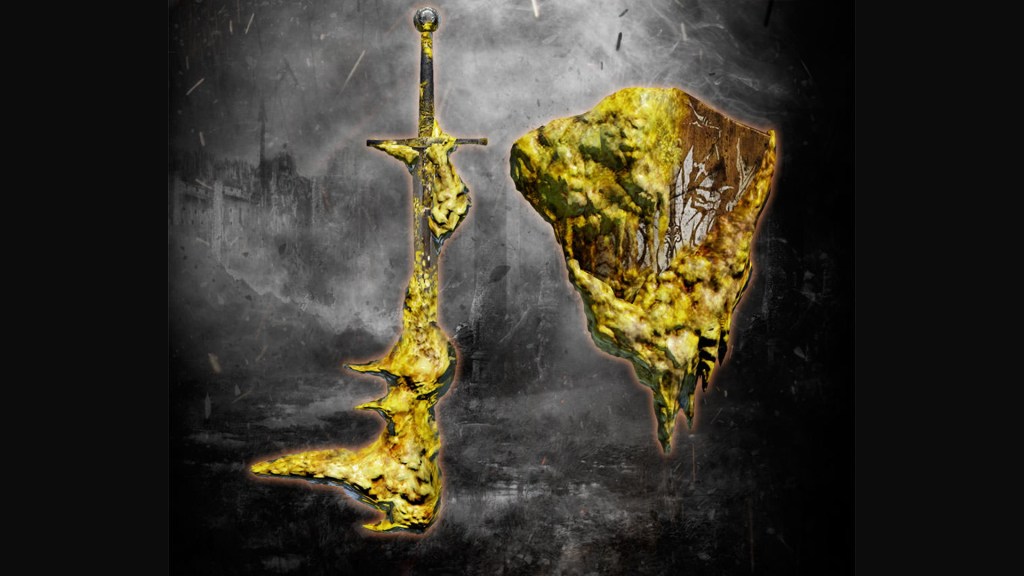
Which reminds me, there was someone like that long ago. He was a vain liar, so he ultimately threw himself into fire. Surely, he should be “molten earth” by now.
Long sword with a yellow crystal clung to it. Found at the bottom of the Melted Iron Castle. It is fragile due to corrosion but light and not inferior in might.
The old king built a castle of iron and collected many weapons to exemplify his own authority. Its glory was his own arrogance and thus sunk into the molten earth.
The rock of this mountainous region has been imbued with the power Gwyn wields and so can be manipulated as an extension of his will, hence the lava’s surprisingly violent reaction to the Iron King’s direct attempt to harness its power — as well as that of the Smelter Demon. The description for the golem’s soul wonders if the iron mass that possessed life had been in the molten earth from the start. This clearly isn’t referring to the Smelter Demon itself given its unambiguous origin according to other item descriptions. Therefore, it must refer to the essence of the iron mass, the will animating it in soul and body. As this being’s Japanese name suggests, it is a demon of “melted iron” — that is to say, iron that has been altered by the power of Gwyn. And if the King of Light controls the molten earth, would he not also influence the melted iron? The Smelter Demon came to life because the fire imbuing it with power had also given it the will of another soul, a more powerful soul.
Soul of the Melted Iron Demon that wanders the castle which sank in iron.
The Old King of Iron was destroyed by a mass of iron that possessed life. Was it there from the beginning, or was it created by the king’s conceit?
The special soul this demon possesses is used to acquire a vast amount of souls or create a great power.
And what was that soul’s will? To indiscriminately rampage? Unlikely. Gwyn had spent his final centuries in the flesh as the guardian of the First Flame, his soul both fueling the fire and protecting it from any potential threats. In fact, it is possible that his soul’s ability to produce fire is linked to his onetime role as Lord of Cinder, as it was only after linking himself to the fire that the god was able to conjure and wield flames. This would imply that his soul is still tied to the First Flame despite their apparent longtime physical separation. (a concept expanded upon with the Lords of Cinder in DS3) Regardless, it isn’t an overstatement to say that the Great Lord’s final will was the preservation of fire. In that light, his soul’s generation of fire and violent reaction to attempts to subsume it make sense. This will behind the fire would also explain why the Smelter Demon’s armor set possesses petrify and curse resistance, attributes most commonly seen in tandem with magic casters and cursed individuals.
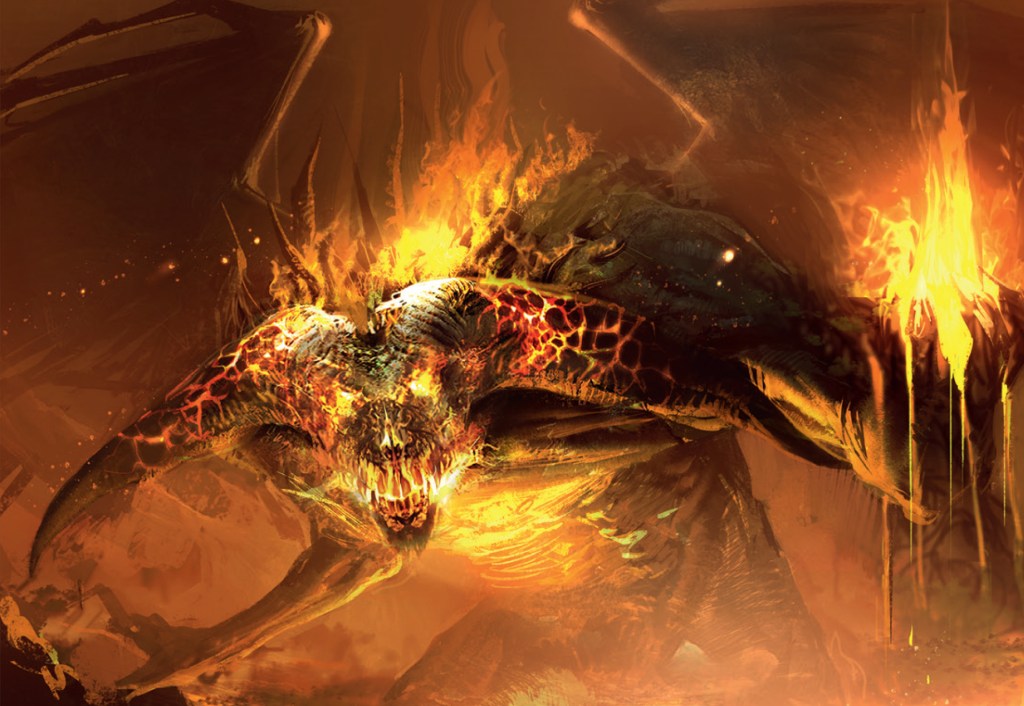
Why possess the Old Iron King then when Gwyn’s soul had no apparent interest in directly controlling the iron puppet? Perhaps it soul felt an affinity for the other due to their like-minded egotism and so instinctively assimilated it, at which point Gwyn’s strong will reanimated the charred corpse and twisted into a new form. Otherwise, not much has changed for the dregs of the King of Light’s once mighty soul. Until we approach the more ruined parts of the Iron Keep, the Old One remains beneath the surface of the molten earth. Meanwhile, the Smelter Demon has been left to “wander” the sunken castle, though we appear to catch it resting when we first enter its boss room. The Alonne Knights and heavy iron soldiers continue their duties as if the castle is not halfway submerged in lava. And with the collapse of the government, the kingdom as a whole falls into chaos, including the ironworks.
Great hammer created from the soul of the Old Iron King. The rock at the tip is condensed molten earth.
Something which became molten earth acquired the Old Iron King’s remains by possessing it.
The soldiers and laborers of Brume Tower are all Hollow. With no sign of enemy combatants, the Old Iron King’s troops more than likely turned on each other after his death, probably vying for control over their dead king’s iron and thus his kingdom. Whoever controlled Brume Tower controlled all the wealth in the nation, and the fact a fair number of these hollows are missing their heads or legs suggests greed brought out their brutality. But when the soot finally settled, the only ones left standing were the mad and immortal. Similar events probably occurred across the rest of the land, fracturing the nation until it was inevitably reduced to ruin. In his avarice, Alken’s king of iron destroyed all the things he had and had already obtained, leaving behind only ruined monuments of his arrogance haunted by monsters. One must wonder if it was worth everything he sacrificed, and everyone.
Condemned to Oblivion
With the Old Iron King’s fall, we must also question the fate of Alken’s rival and its unnamed Queen. How did she feel when the beloved she had shown mercy to suddenly struck back before going on to essentially cage Venn? It must have been humiliating for the kingdom, but more than that, it must have been personally heartbreaking to her. A chest in Belfry Luna contains the Blue Tearstone Ring representing the blue tears Caitha sheds for those who have lost loved ones. While the loss the goddess cries over is specifically in the sense of death, it is true that the Princess of Venn had — in a more general sense — forever parted with her beloved ever since becoming Queen. Nowhere was this loss more evident than after her sweetheart carried on Alken aggression. Were they not both in the perfect position to end their two countries’ long history of bloodshed? Was this not the chance to unite their kingdoms if not their hearts? Perhaps he still felt the same, but power and pride apparently superseded his love for her, which likely came to her as a betrayal. For it made her the fool and, even worse, complicit in sabotage by the enemy. It is these circumstances that led her to become the Lost Sinner.
There are two prevailing theories about the identity of this “forgotten sinner”: one, that the prisoner is the Queen of Venn; the other, Eygil. Both assume that the person was imprisoned for attempting to create a First Flame thanks to Shalquoir’s dialogue, but this misunderstands who the cat is referring to. In all of her commentary on the bosses possessed by the Old Ones, Shalquoir starts by musing on the person possessed or location where we encounter the boss. However, she invariably ends her final sentences with a veiled reference to the true being behind the battle, using a double entendre for the current states of both souls. In the case of the Lost Sinner, the cat contemplates the role of the prison before relating about the “stupid” forgotten sinner who tried creating a First Flame occupying the equally forgotten prison. This is an obvious reference to the Witch of Izalith and doesn’t necessarily reflect the crimes of the prisoner, thereby leaving an open question to the actual nature of the convict’s sins.

Long ago, there were humans who tried to contain Undead like you. Did they think if they imprisoned them all they’d thereupon end it? They made a big prison… but in the end, it was all pointless. There’s a “forgotten sinner” in the far back of that prison. A stupid sinner who tried to birth a First Flame…
Assuming that the Lost Sinner is Eygil, the crime is obvious. He was a magic caster employed by the royal court of an enemy nation. There would be every reason for Venn to capture him after the collapse of the Old Iron King’s regime. Likewise, the height, physique, and apparent beard beneath the mask lead many to believe that the Lost Sinner is in fact male — indeed, the gender is never made explicit in any item’s Japanese description. There is also the fact that the boss is accompanied by two pyromancers who drop down chutes from adjacent cells in NG+. Eygil himself practiced the flame arts Izalith invented, and the penal set provides a similar resistance ratio to that of a pyromancers’ tattered cloth set; the slightly more resistance to the Dark than magic can be attributed to exceptionally long confinement in a dimly-lit cell. Some even point to the Lost Sinner’s wooden handcuffs as an attempt to prevent the criminal from casting pyromancy. However, there is reason to be skeptical.
Although left ambiguous, Eygil could have easily been killed by the disaster at the Iron Keep or the infighting at Brume Tower. Moreover, the Lost Sinner’s masculine features don’t strictly exclude the character from being a woman — the butch Hollow cooks from DS1 are a testament to that. As for the other two pyromancers, they can just as much be referencing the founder of pyromancy possessing the Lost Sinner as the Sinner being a pyromancer. The same can be said for the penal set, which has similar resistance ratios to not only clothes worn by pyromancers but also armor directly burned by fire or long immersed in fiery environments. And we cannot exclude the effect that Izalith’s soul has on the sinner’s being. Finally, if they intended to prevent the sinner from conjuring flame from the palms of the hand, they would do more than just bind the wrists. But we never once see this supposed pyromancer cast pyromancy. And so, there is no reason for the boss to be strictly a pyromancer, woman, or Eygil.

So, what can be said for certain about this forgotten sinner? For starters, that the criminal was locked up in a large cell in the deepest, most isolated parts of the prison. Two adjoining towers on either side rise into the rock overhang beneath the rest of the facility, and Sinner’s Rise, more accurately “Sinner’s” or “Criminal’s Tower”, (罪人の塔) leads us to the main entrance by way of a single, narrow bridge across the ocean. Countless shackles hang from the metal-barred ceiling, with over a half dozen more dragging across the floor from the walls until they converge to a single spot at the center — presumably having restrained the boss when confinement was still regulated. And aside from chutes to other cells, the jail itself is installed with extensive oil lighting on top of several wall torches. Red banners also hang from the back walls. This is an extremely luxurious cell for just a single prisoner, indicating that its occupant was a VIP of some sort. And yet, this luxury didn’t extend to the VIP in question.
Handcuffs, a straitjacket, and a heavy metal mask poking spikes into the face — the intention was to torture the sin. This explains why the boss has a sword on-hand. While the blade’s English description claims its true nature to be unknown to even the boss, the actual text merely repeats the same statement made in the penal set descriptions: both the prisoner’s background and crimes are now long forgotten. In truth, she wields what is, by all appearances, a normal, unassuming sword. The blade we acquire harms us when swung and deals less damage to enemies as we increase our sin levels, but this is likely because it derives from the Lost Sinner’s soul — a soul that was charged with self-punishment for sins and thus creates a weapon maximizing self-harm for fellow sinners. Maybe it had originally been a means to have a dignified way out, but this was a prisoner who felt duty-bound to suffer, and the faded bloodstains on the cell floor suggest much suffering.
Extra large sword created from the soul of the Forgotten Sinner. The power of its blade shaves off the life of the wielder.
Her background and the sin she committed are now long forgotten. The one who handles this sword will be burdened with the punishment that was imposed on the Sinner.
Soul of the Forgotten Sinner, who was captured in the Sinner’s Tower.
The Sinner bore the responsibility to continually punish herself as retribution for the sin she once committed.
The special soul this sinner possesses is used to acquire a vast amount of souls or create a great power.
Another element to consider is the boss’ soul. The menu graphic for the Soul of the Lost Sinner matches that of the Old Iron King as well as other monarchs of similarly great prominence and strength. Put simply, the Lost Sinner would need to have acquired the same amount of power as a heroic ruler during life, something few humans outside royalty have accomplished. Therefore, the boss must be someone comparable to royalty, experienced in combat, imprisoned at the Lost Bastille, and have reason to be self-loathing over some wrongdoing — the Queen of Venn checks all the boxes.
The Queen would have every reason to feel culpable for the King of Alken’s continued aggression, and there may well have been suspicions of her fraternizing or even conspiring with the enemy among the court, assuming her forbidden romance wasn’t somehow exposed. And whether at her suggestion or public condemnation, she would be imprisoned while still given some luxuries befitting her status. Either way, she would cooperate with her torturers. Behind the doors at the back of her cell is a chest containing an Elizabeth Mushroom. Its healing powers make it useful for surviving harm while its description casts doubt on the supposed beauty of the woman behind it, which mirrors the prisoner if she is the Queen who once caught the eye of an enemy prince and now tortures herself — in more ways than one.
The Queen’s mindset is also easy to envision. Stored with Elizabeth’s secret medicine is a Fragrant Branch of Yore, wood from a tree with a sweet smell that evokes nostalgic memories powerful enough to even reverse petrification. Combined with the red hue of her cell’s banners, and the Queen likely spent much of her time reminiscing about her old flame. Her romance was a time she dearly missed, a time where she was young and ignorant and enraptured in a love she believed would go on forever. But no matter how much she pines for those memories, it won’t change reality. She has been unable to let him go, and a result felt fooled, betrayed, heartbroken, and deserving of all the world’s hatred because of it. And so, she eternally punishes herself for her foolishness all the while wishing she could return to those happier days. Maybe that is why writings in the stone plaster her cell, signaling its occupant to be very bored, lonely, or not the picture of mental health.
This is in all likelihood what drew the soul of the Witch of Izalith to her. After entering the boss room, we see a tiny insect hanging from an eyehole in her mask. This bug is identical to the parasite found at the core of the Bed of Chaos in DS1, save for its smaller size, and thus likely to still be the witch’s true body. Considering the specific power of her Lord Soul and the flame it sparked, it is possible for the dregs of Izalith’s soul to reconstruct her living vessel. And no longer host to the flame she created, the bug apparently roamed the land until finally coming upon the Lost Sinner. Both were once royalty who had made mistakes that were ultimately rejected by the world and left to suffer in isolation. The witch probably saw in her a kindred spirit, much like Gwyn and the Old Iron King. And so, the parasite did what they do and latched onto the prisoner. This possession explains why the Lost Sinner has seemed to survive the ages without food or drink, cursed by the strong will of a powerful soul similar to Ichorous Earth.
However, the differences between the two couldn’t be clearer. Nothing has stopped the Sinner from leaving her cell, yet we find her kneeling down with her head low quietly accepting her confinement even after everyone she has known is dead or a monster. Compared to the ambitious witch who turned her mistake into at one point thriving civilization, and its clear who arrogantly embraced her sin and who contritely accepted it. This is only emphasized by the underlying nature of the boss battle. Izalith crawls into the eyehole she hangs from before seemingly burrowing into the Lost Sinner’s head, which is naturally painful to the queen. It is only afterward that the boss takes up her sword to attack us. In other words, it is the Witch of Izalith controlling the body we battle, defiantly challenging anyone who might dare slay the tortured soul she haunts while the queen herself has merely wallowed in misery. Maybe she wants the Lost Sinner to come to terms with her sadness on her own, but she definitely won’t allow anyone to end her life before that, even the Sinner herself.

As for the rest of Venn, it may have carried on. The fume sorcerers were among the “many” soldiers dispatched to take over the Old Iron King’s iron facilities after his death. The fact that they are women dressed in blue wielding magic daggers to conjure what appears to be a kind of lightning sorcery certainly fits Venn — its gargoyles can do the same with their spears, after all. The country would also undoubtedly be interested in retaking lost land. This might mean that the kingdom carried on as normal, unaffected by the imprisonment of its queen, although it was unable to ultimately take the ironworks from Nadalia. Alternatively, the country had collapsed shortly after this attempt and never devoted the resources needed to conquer it. It is possible that the loss of Venn’s queen resulted in similar chaos that befell Alken. But in the end, the kingdom fell apart by the time Drangleic was founded, leaving only two bell towers that continue to ring the love of a star-crossed pair to this day.






